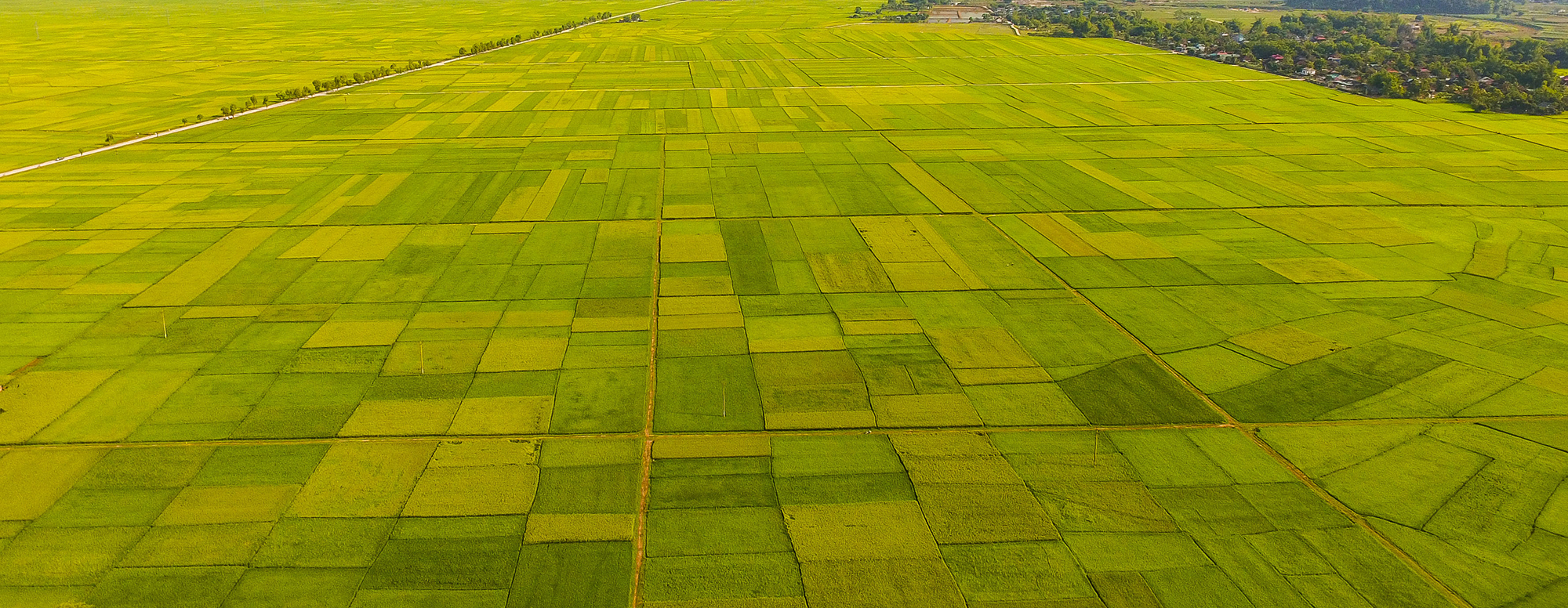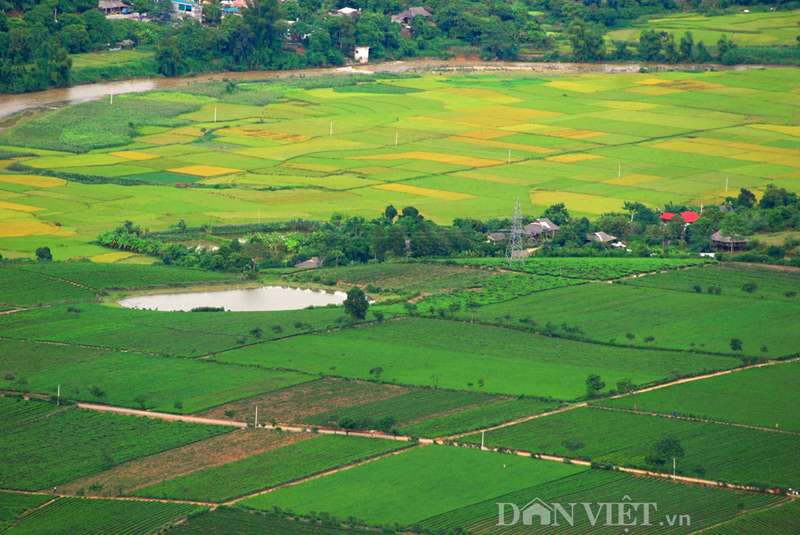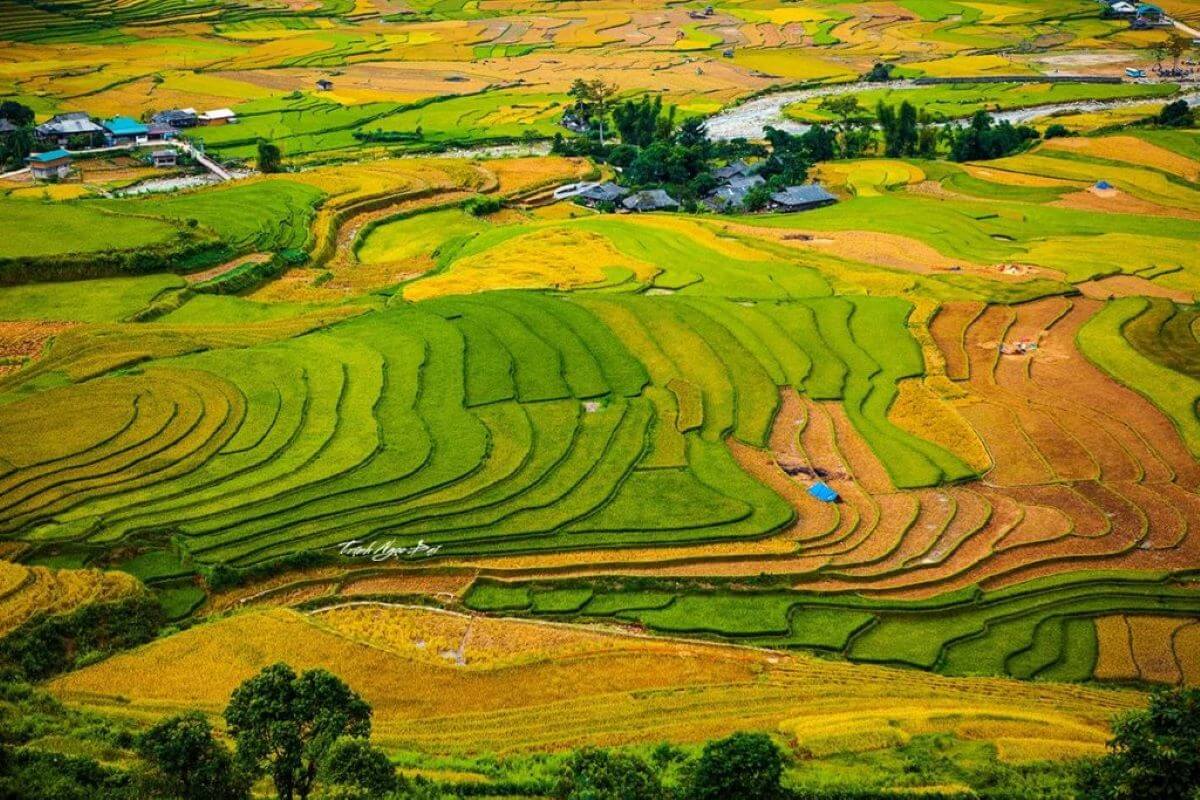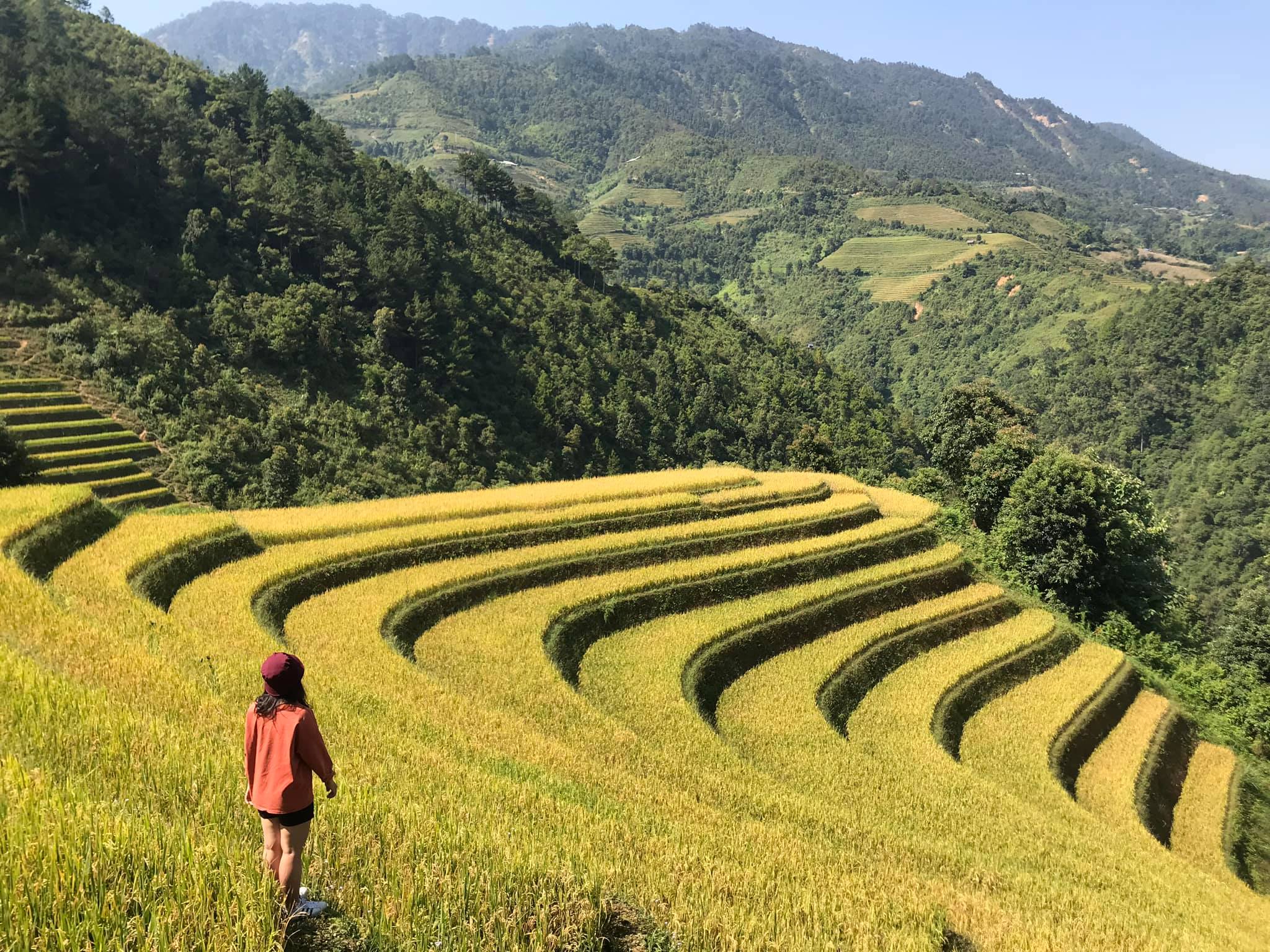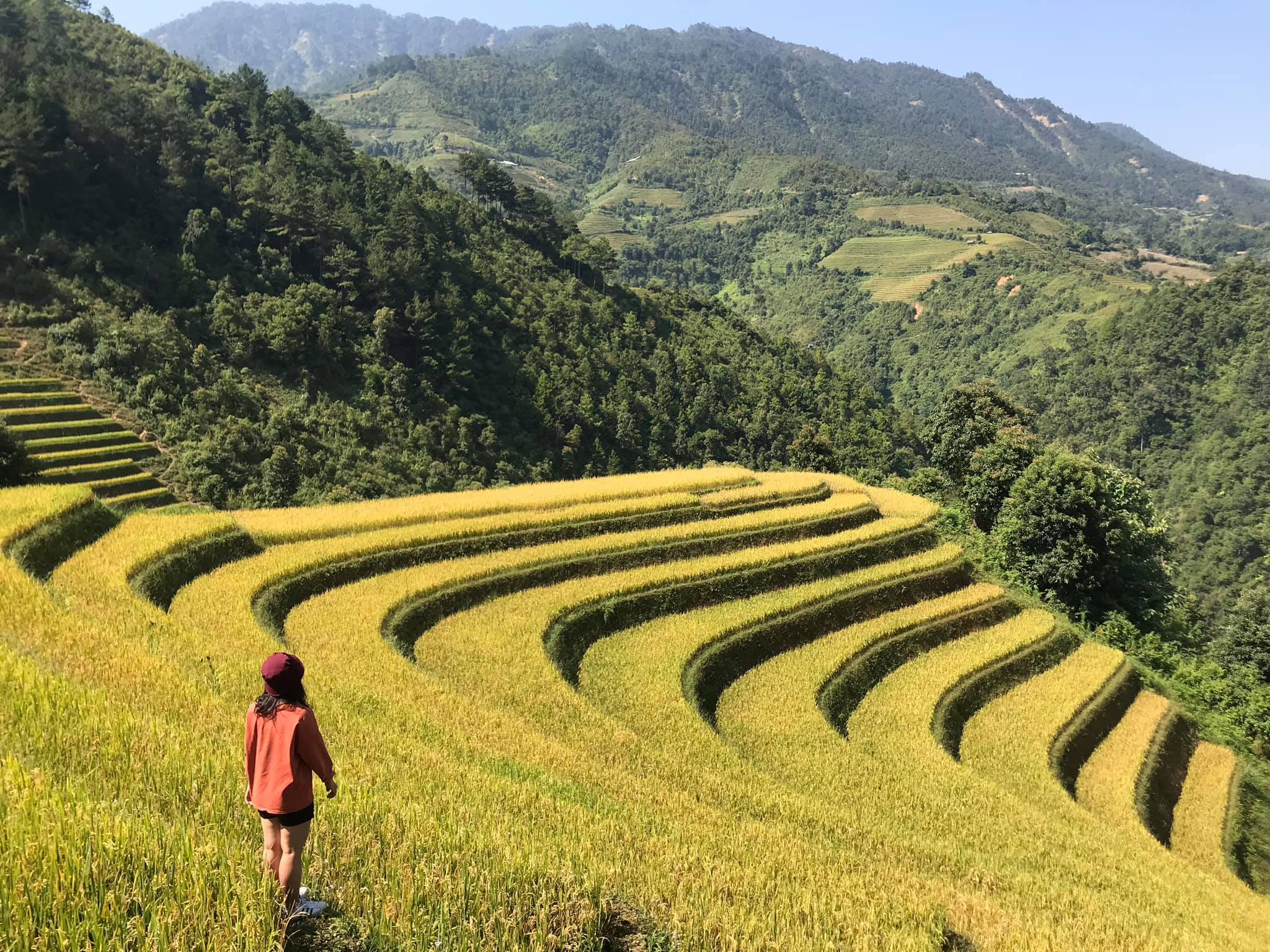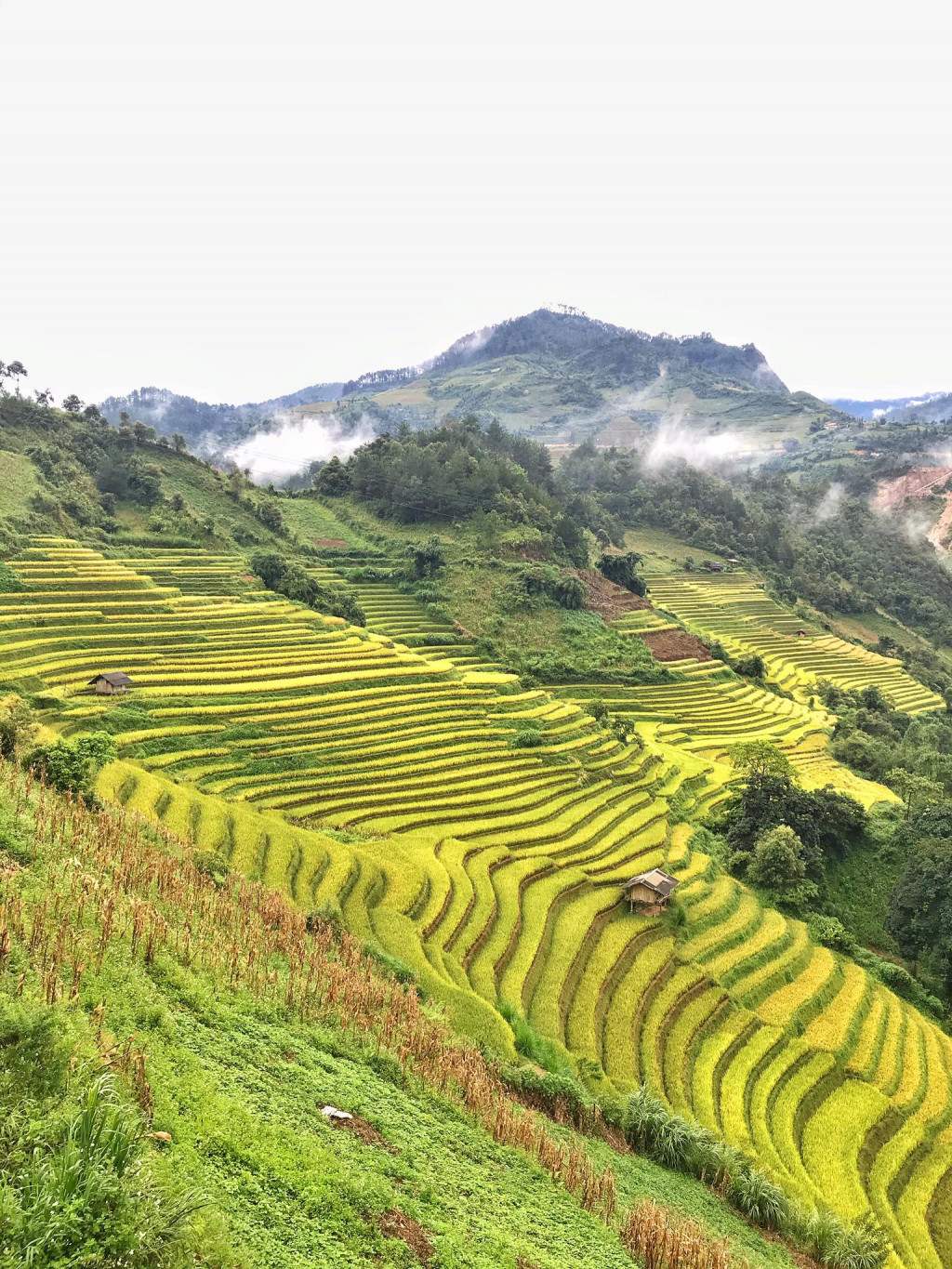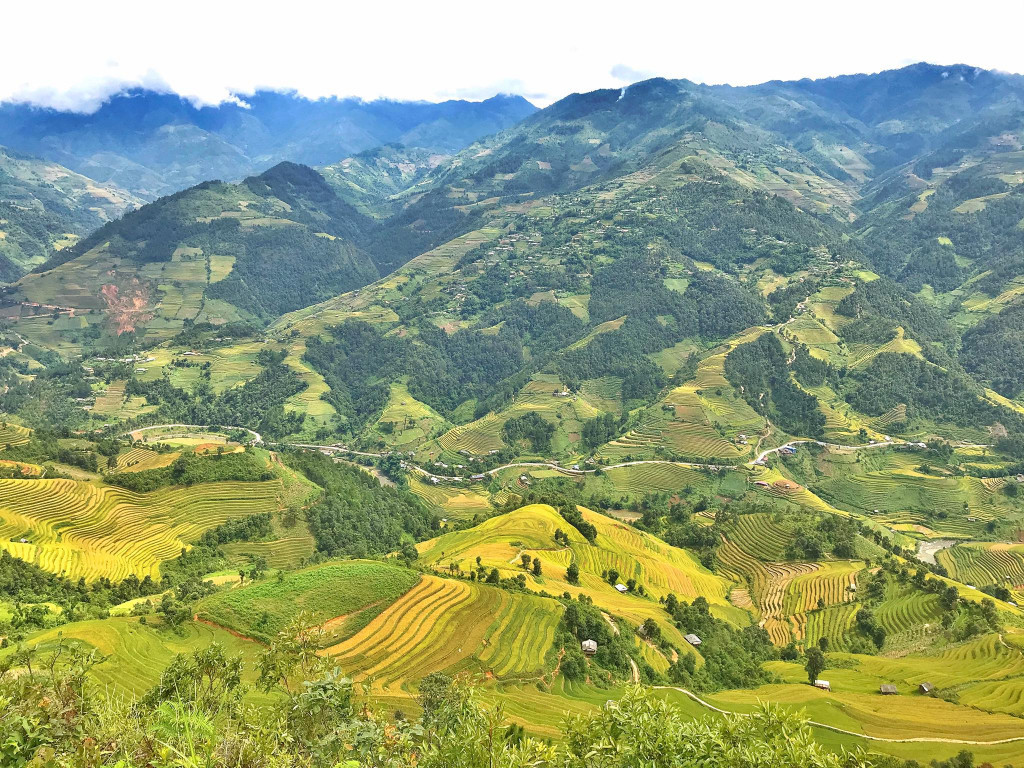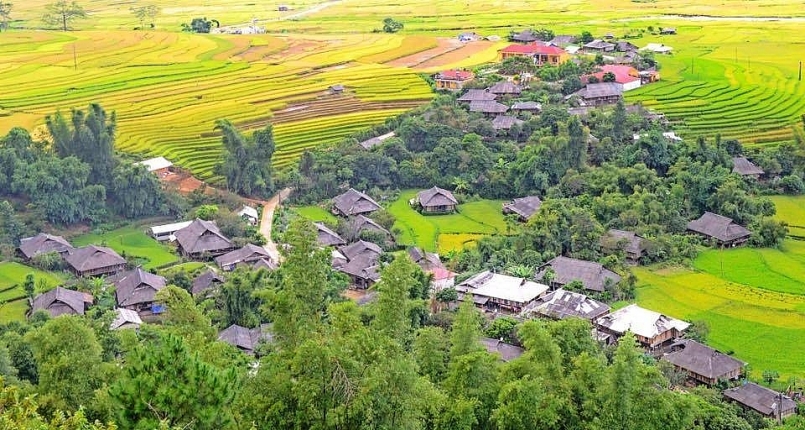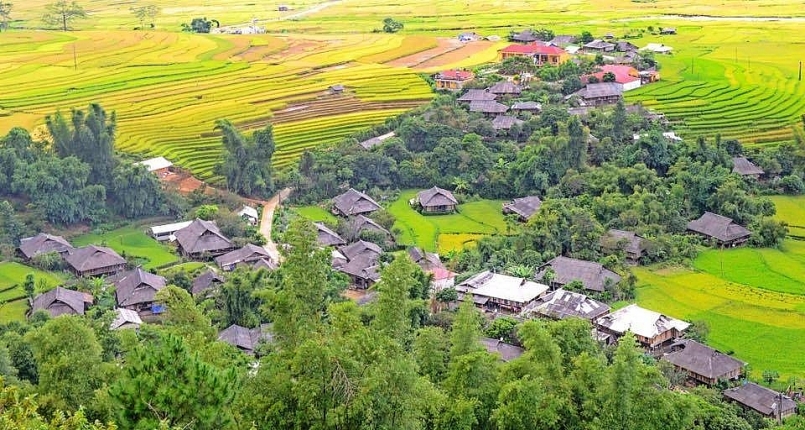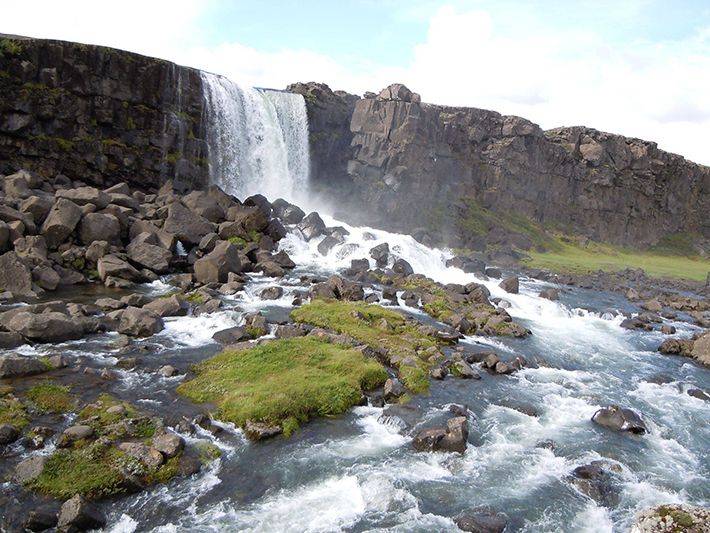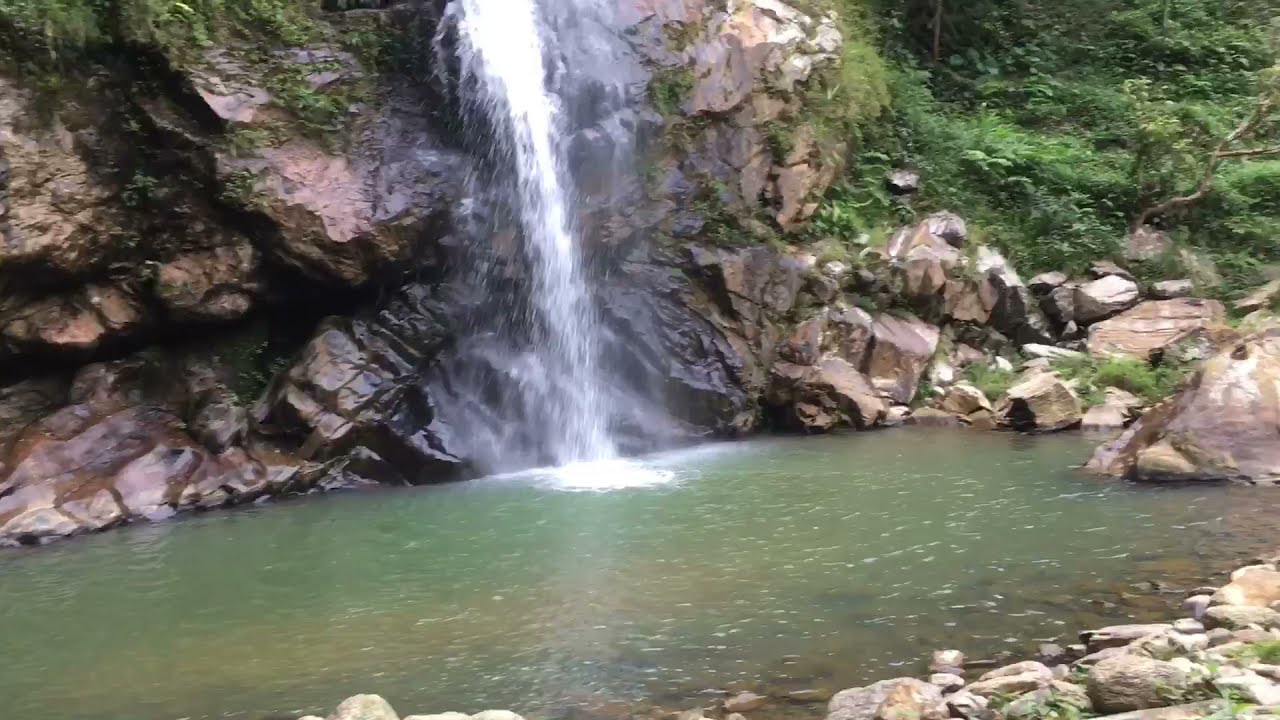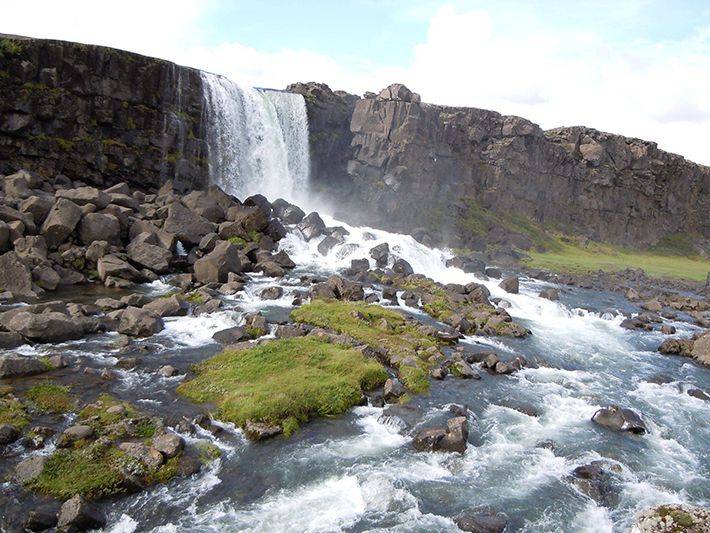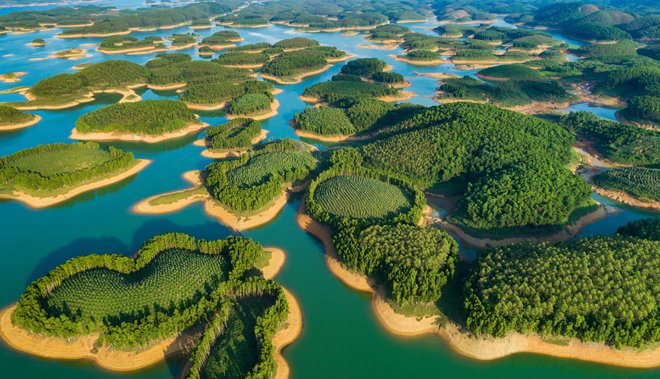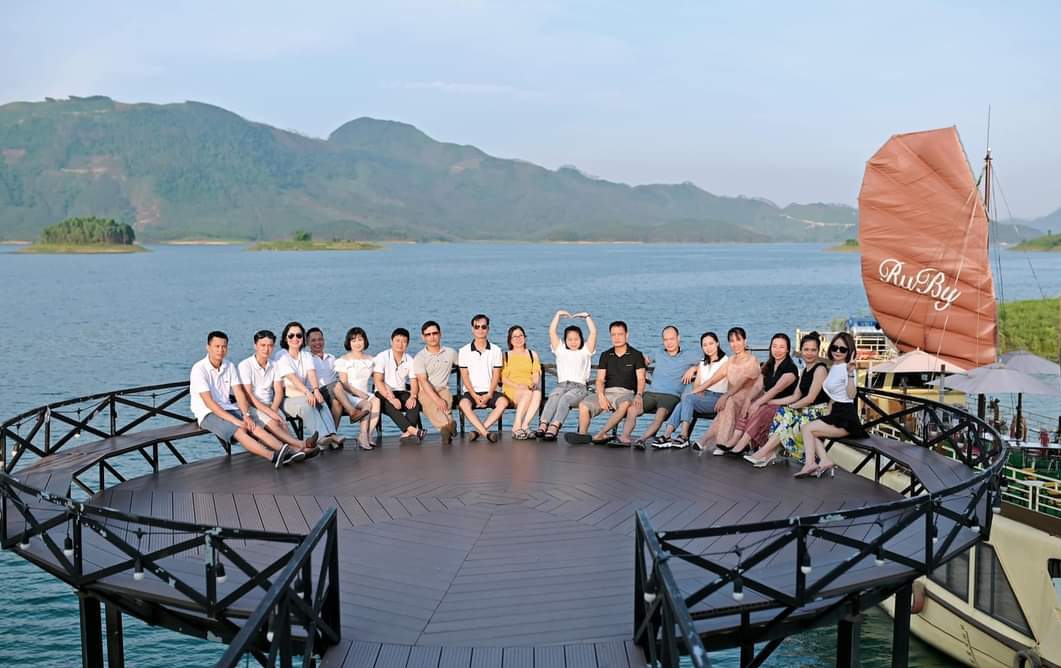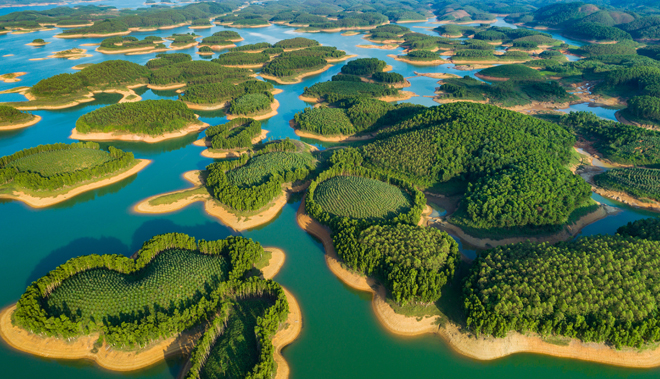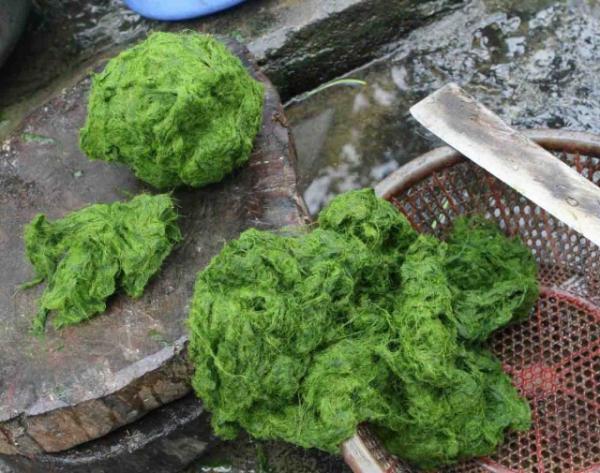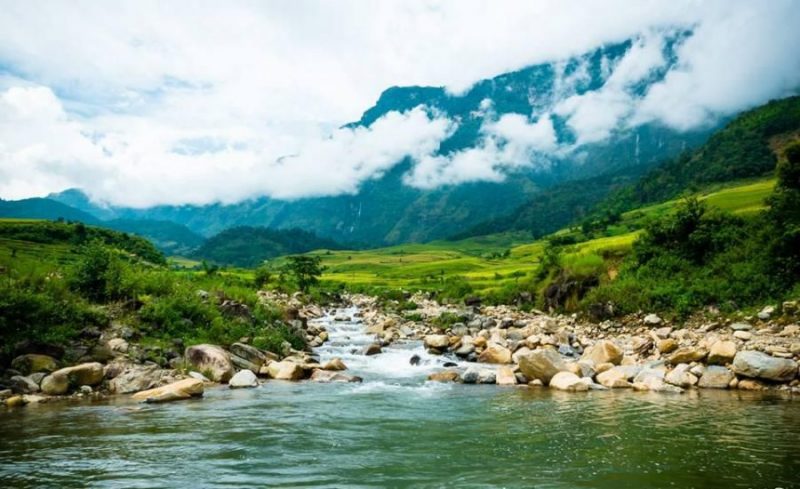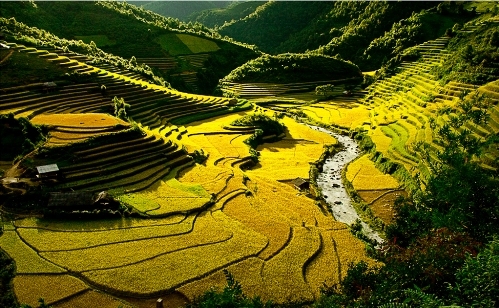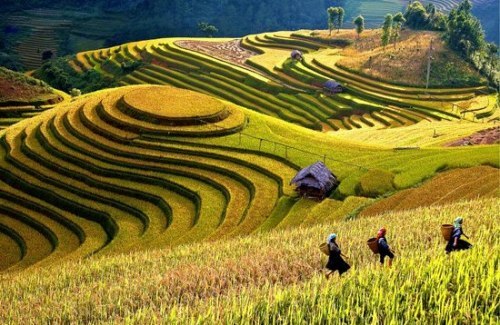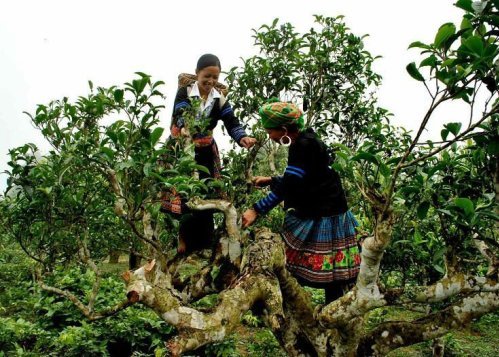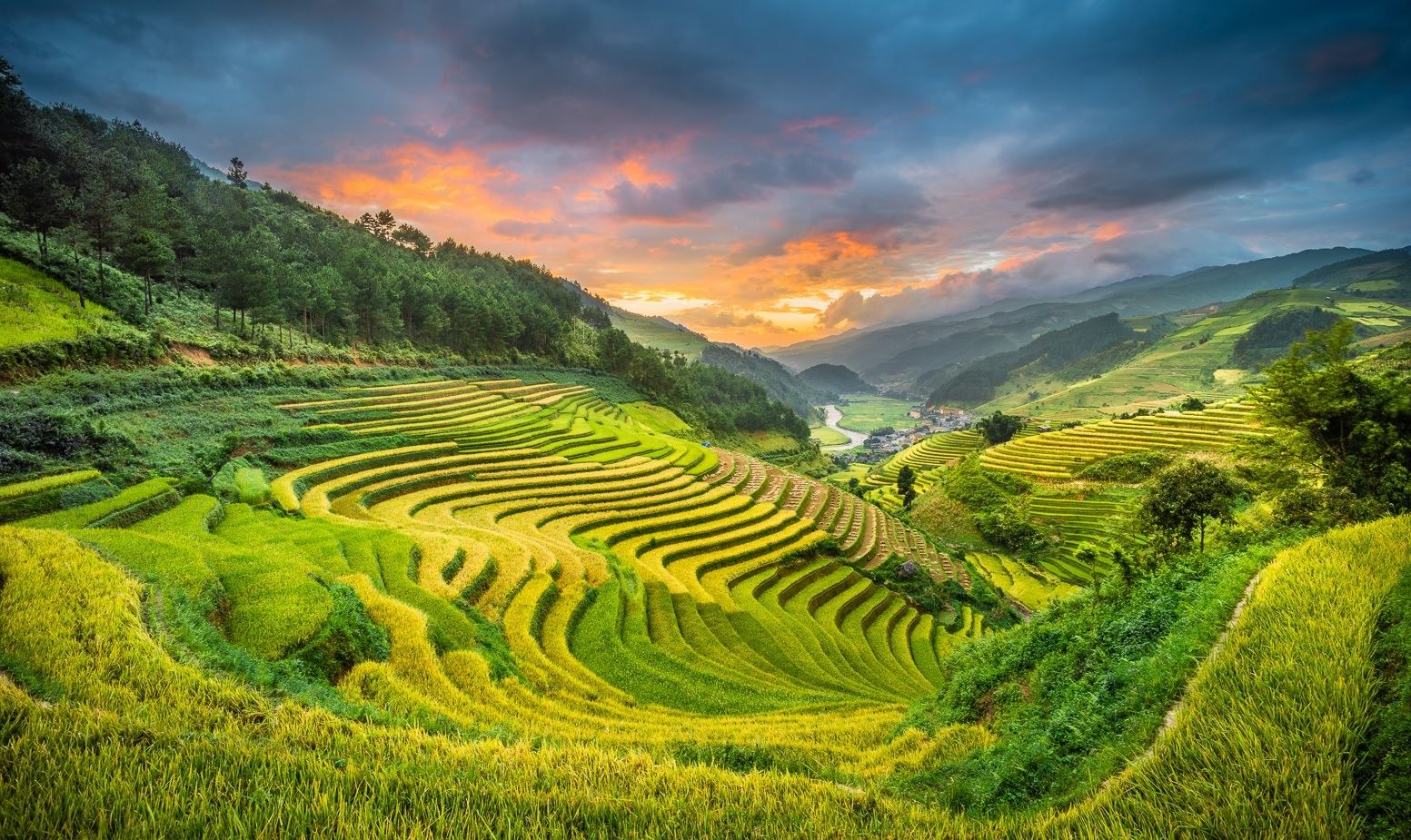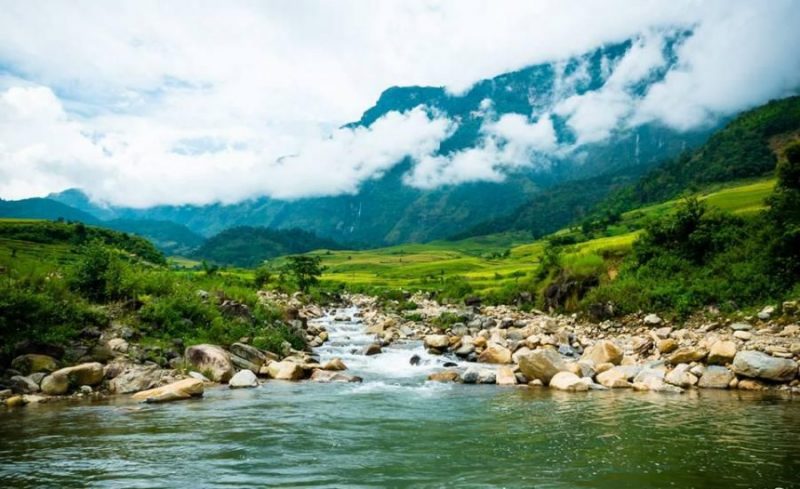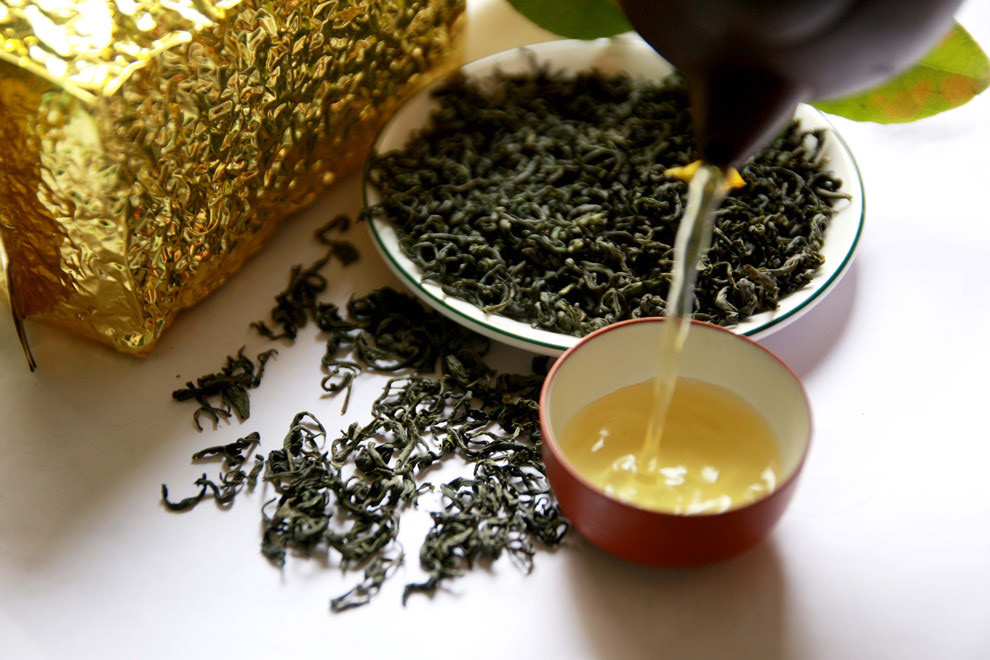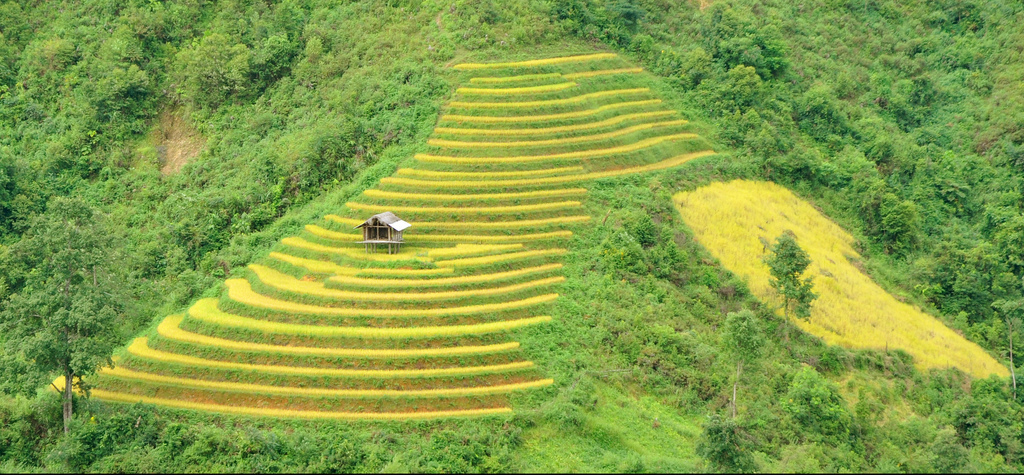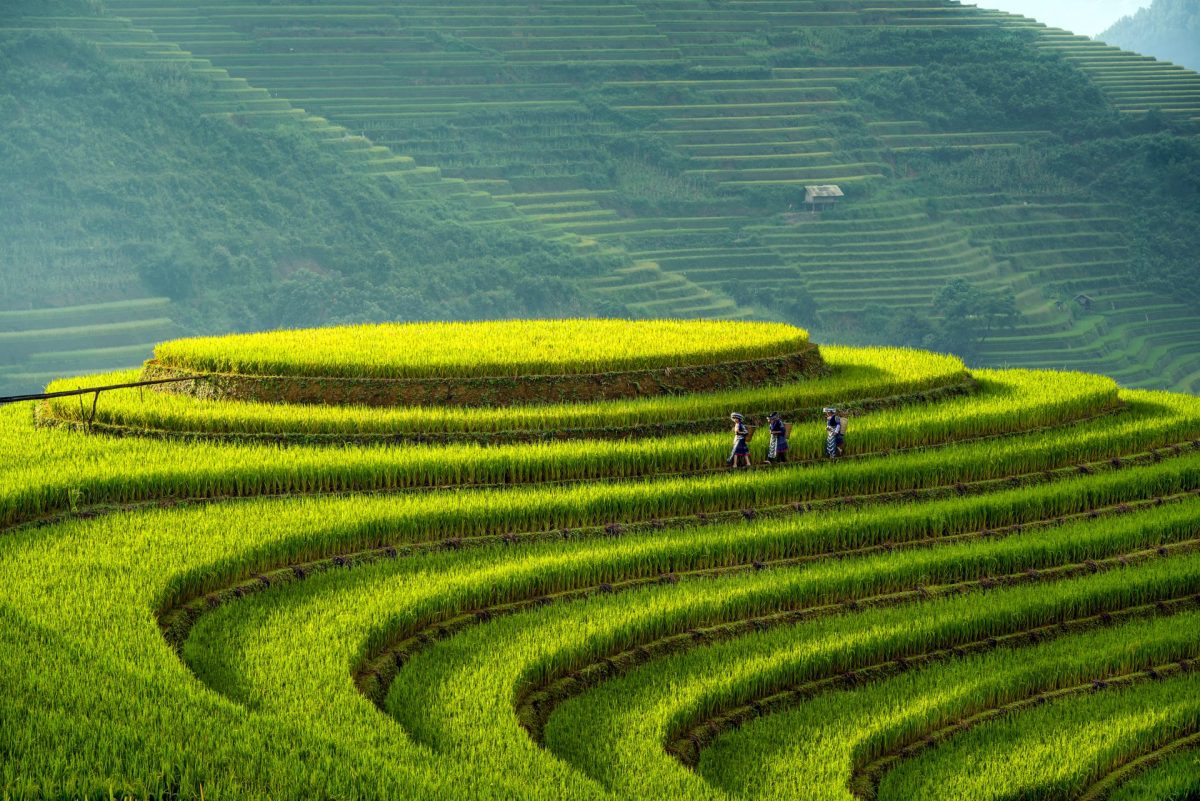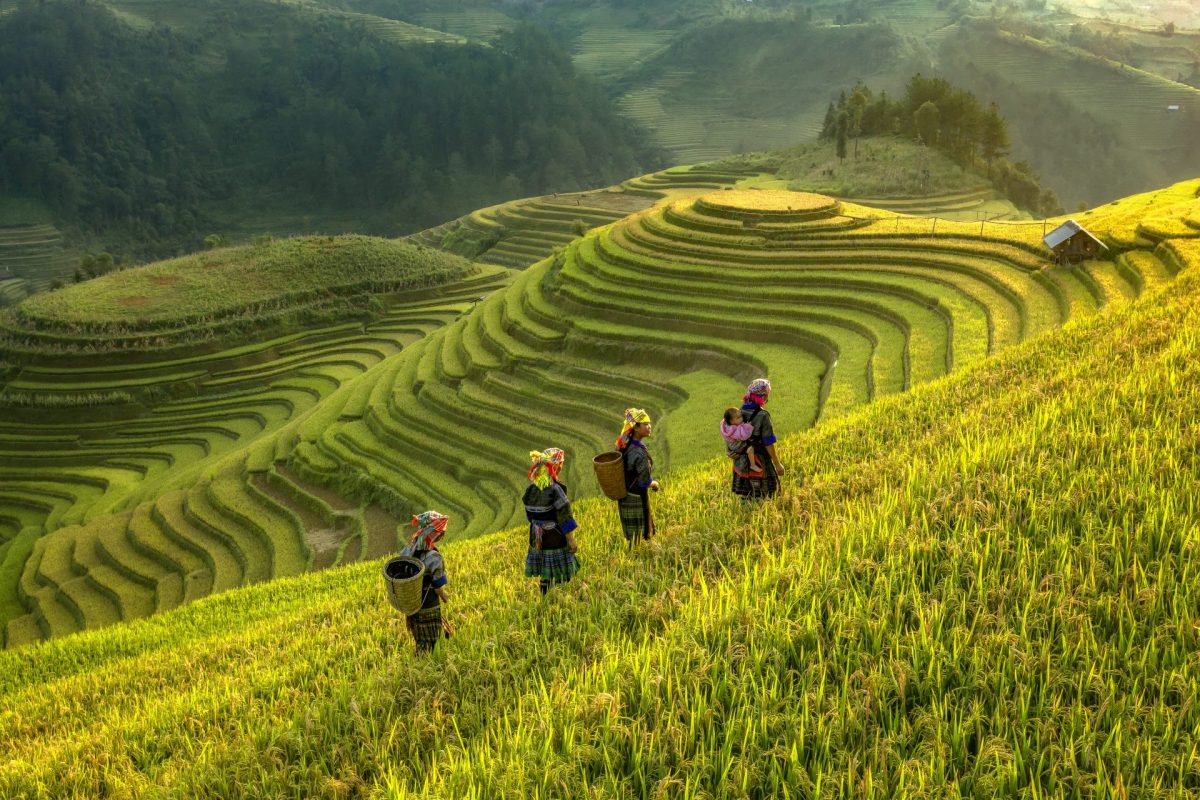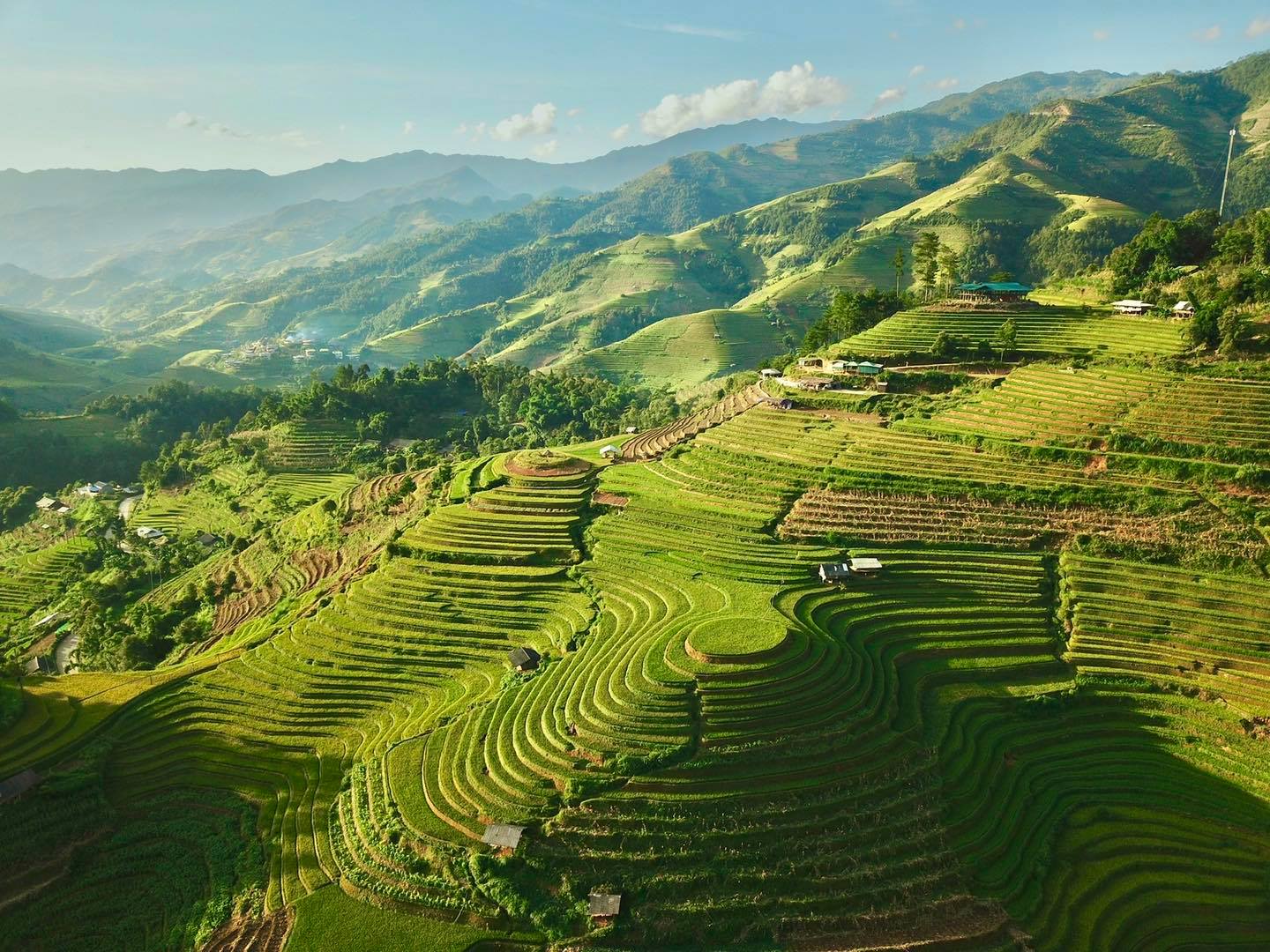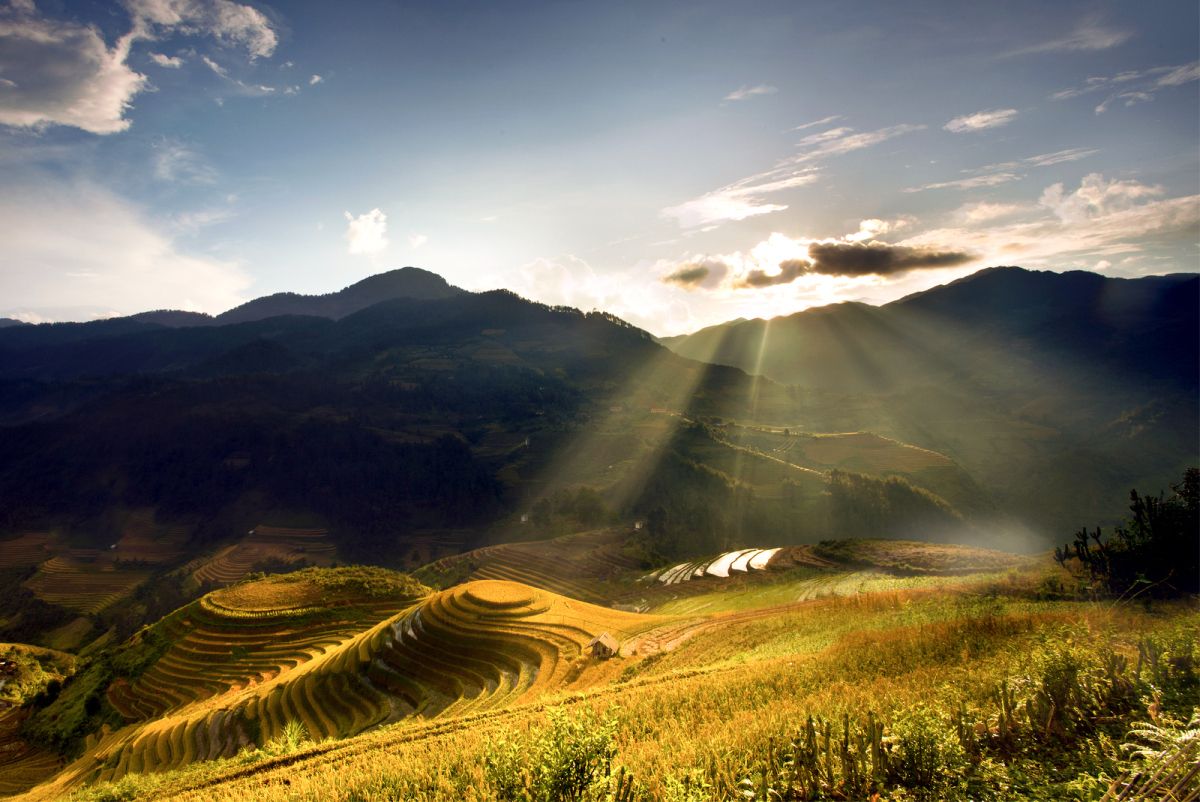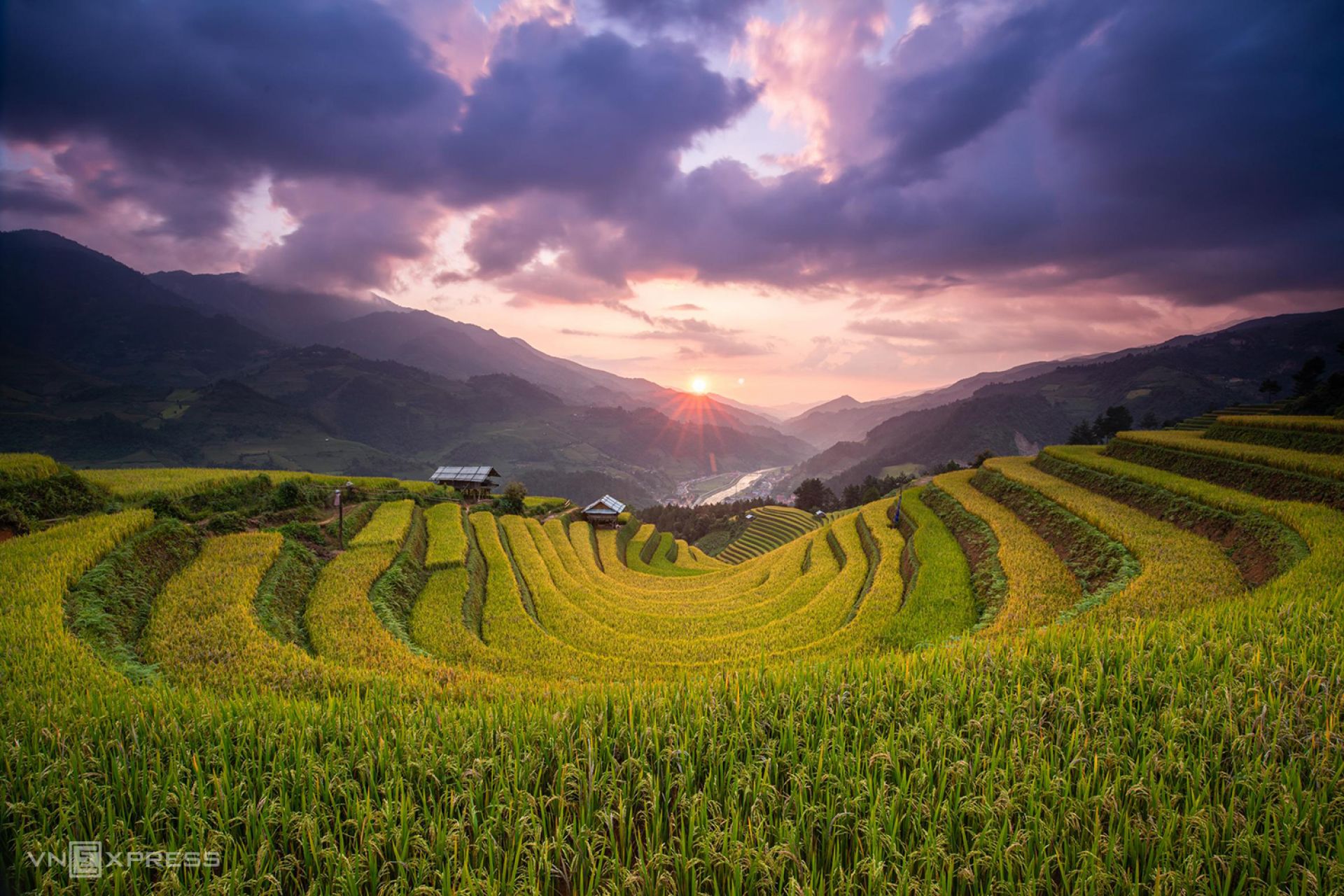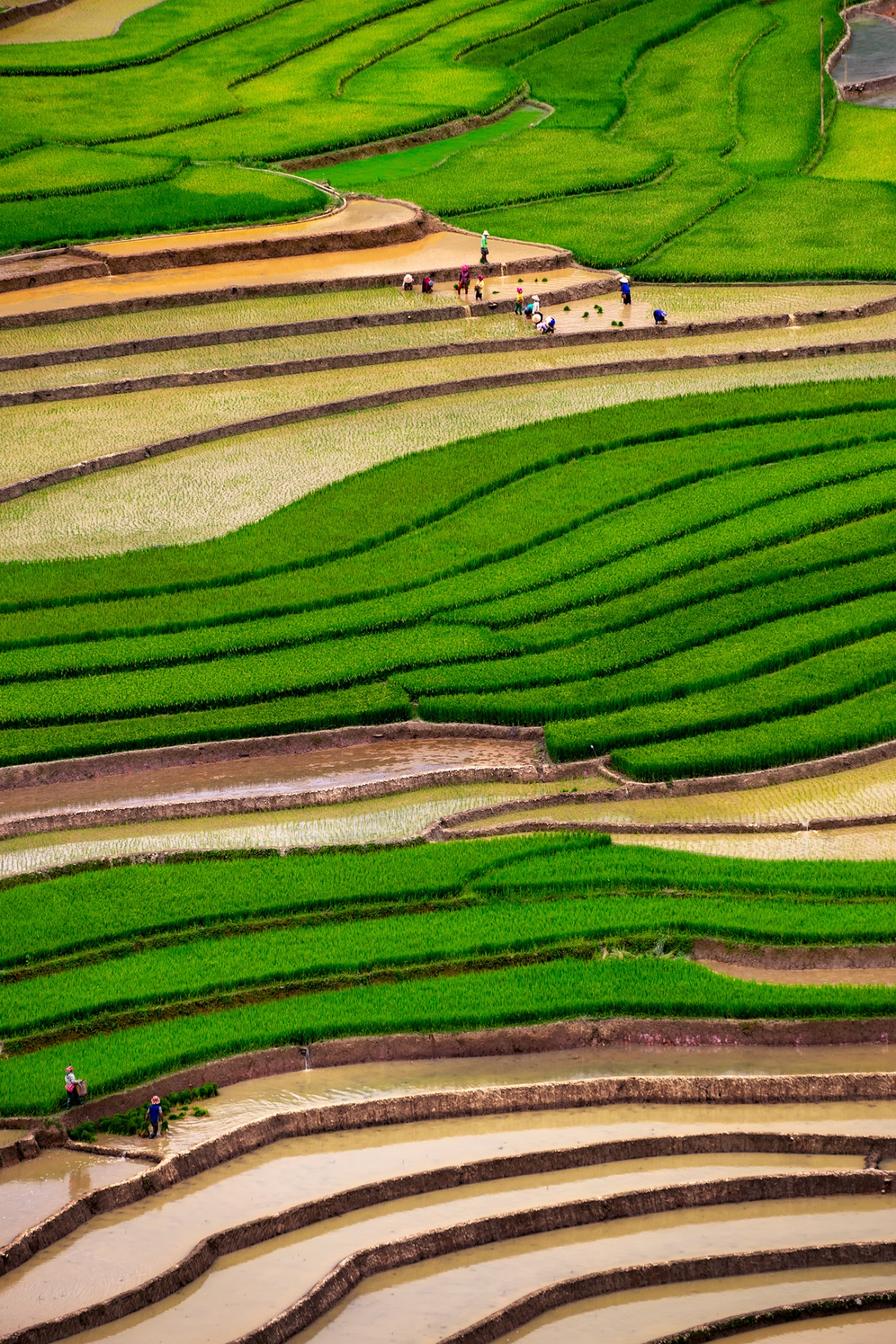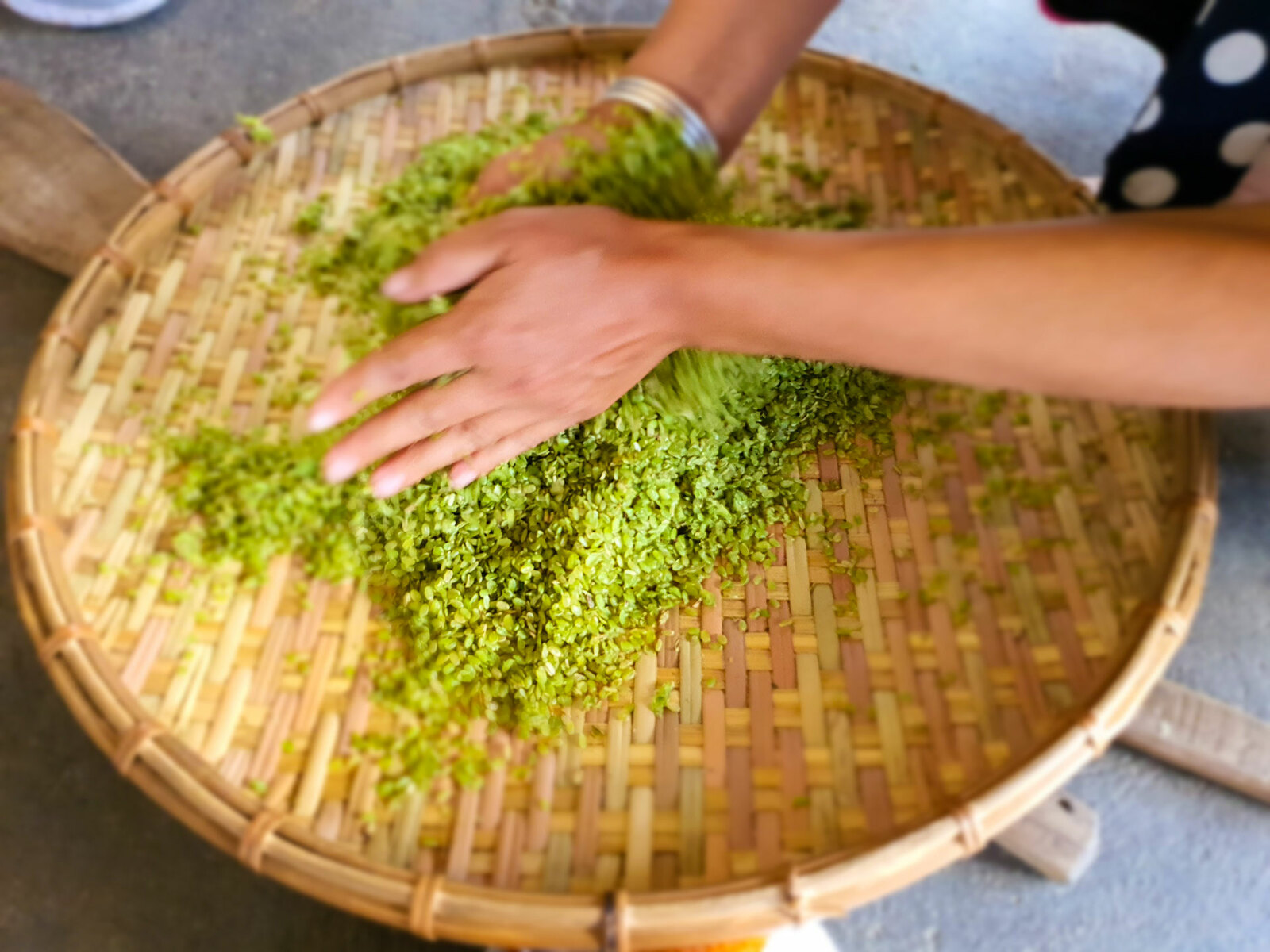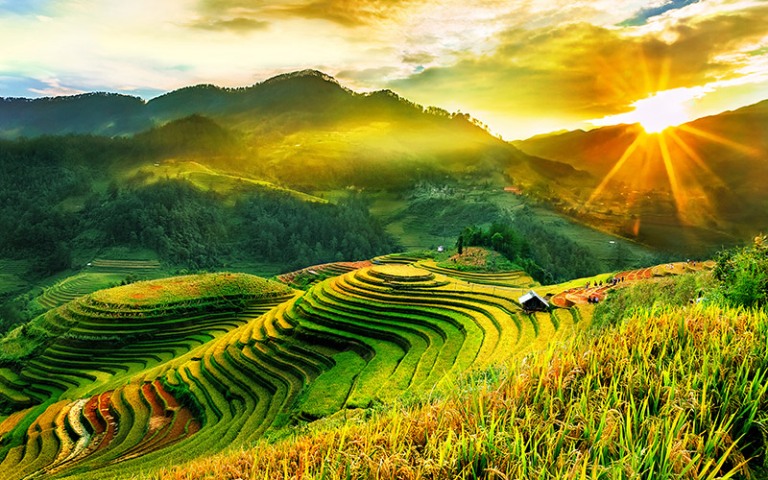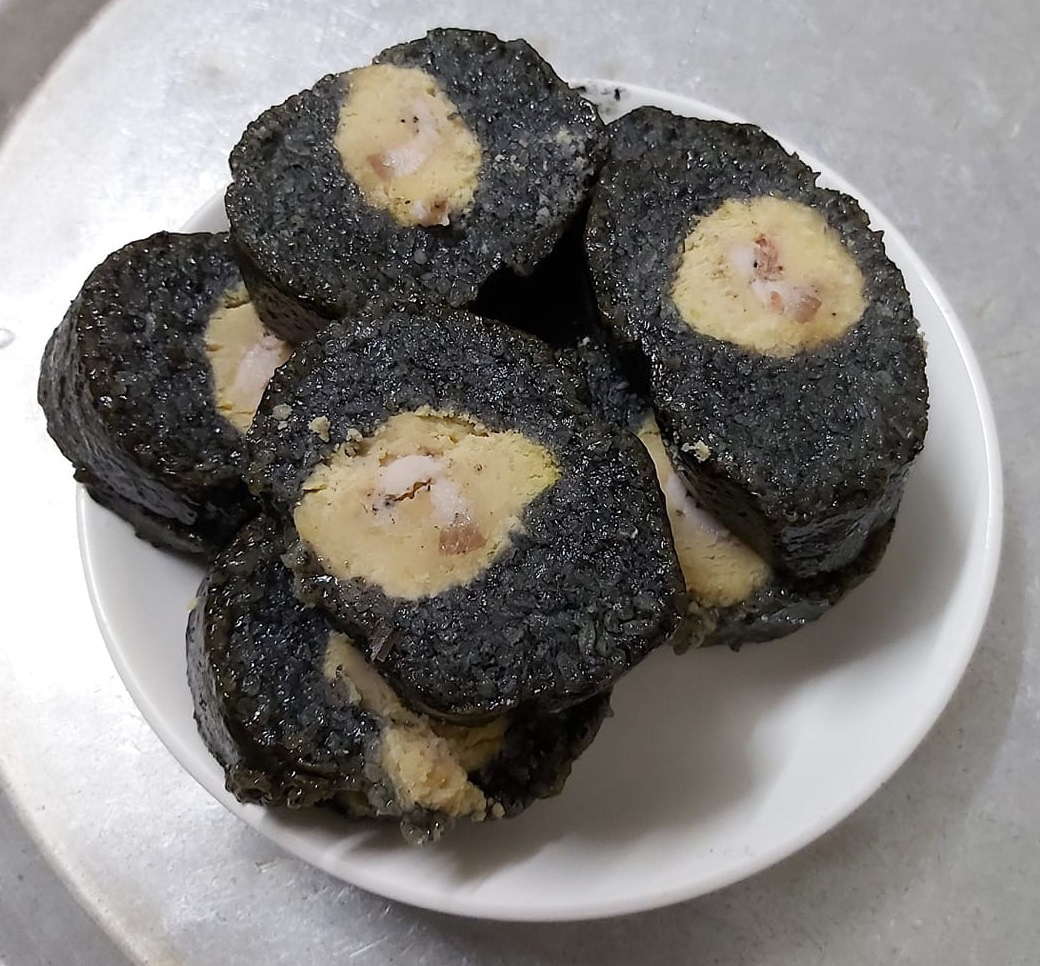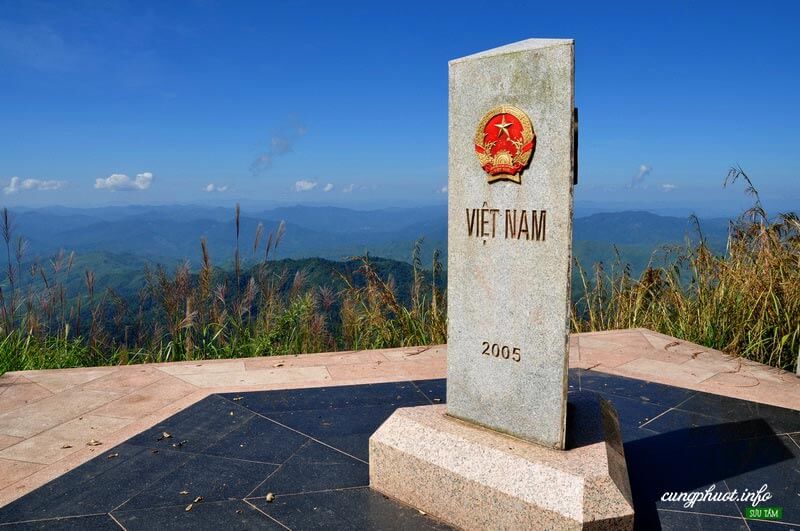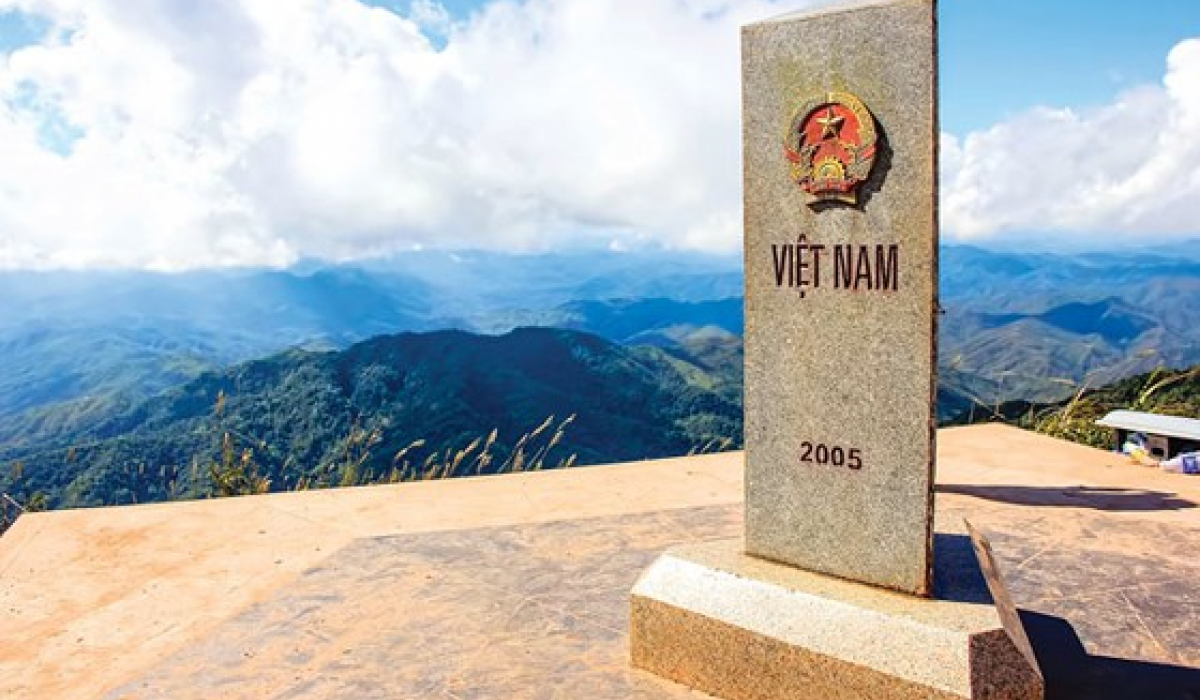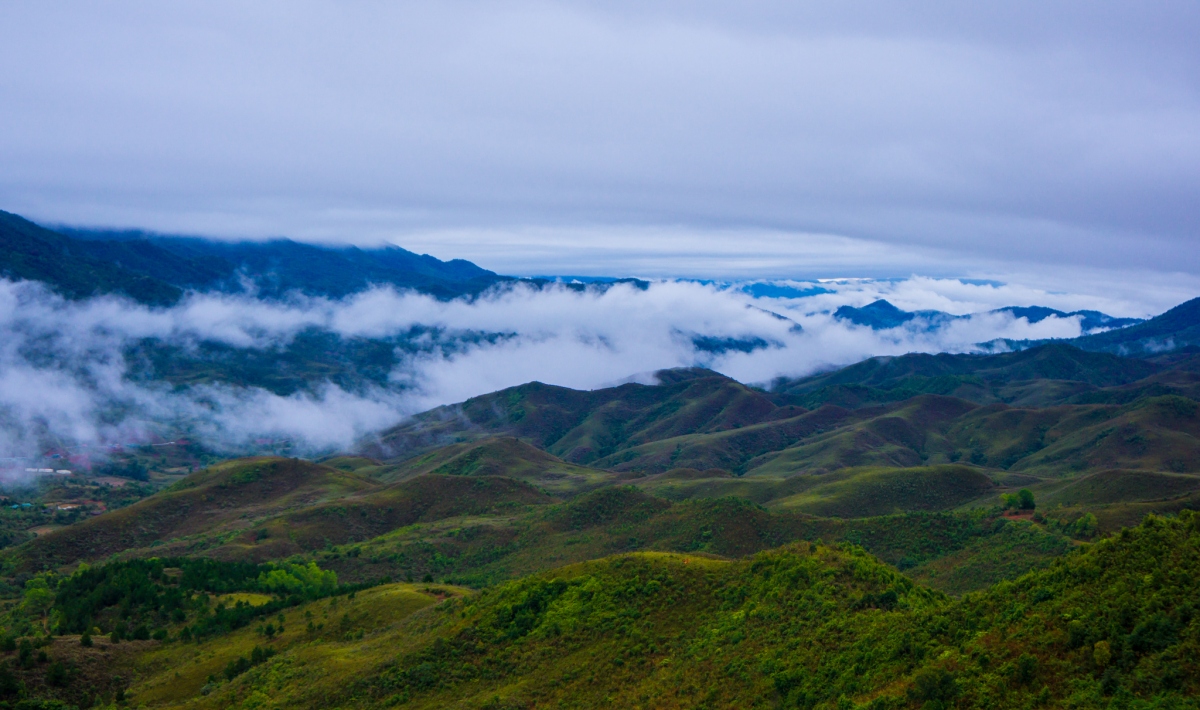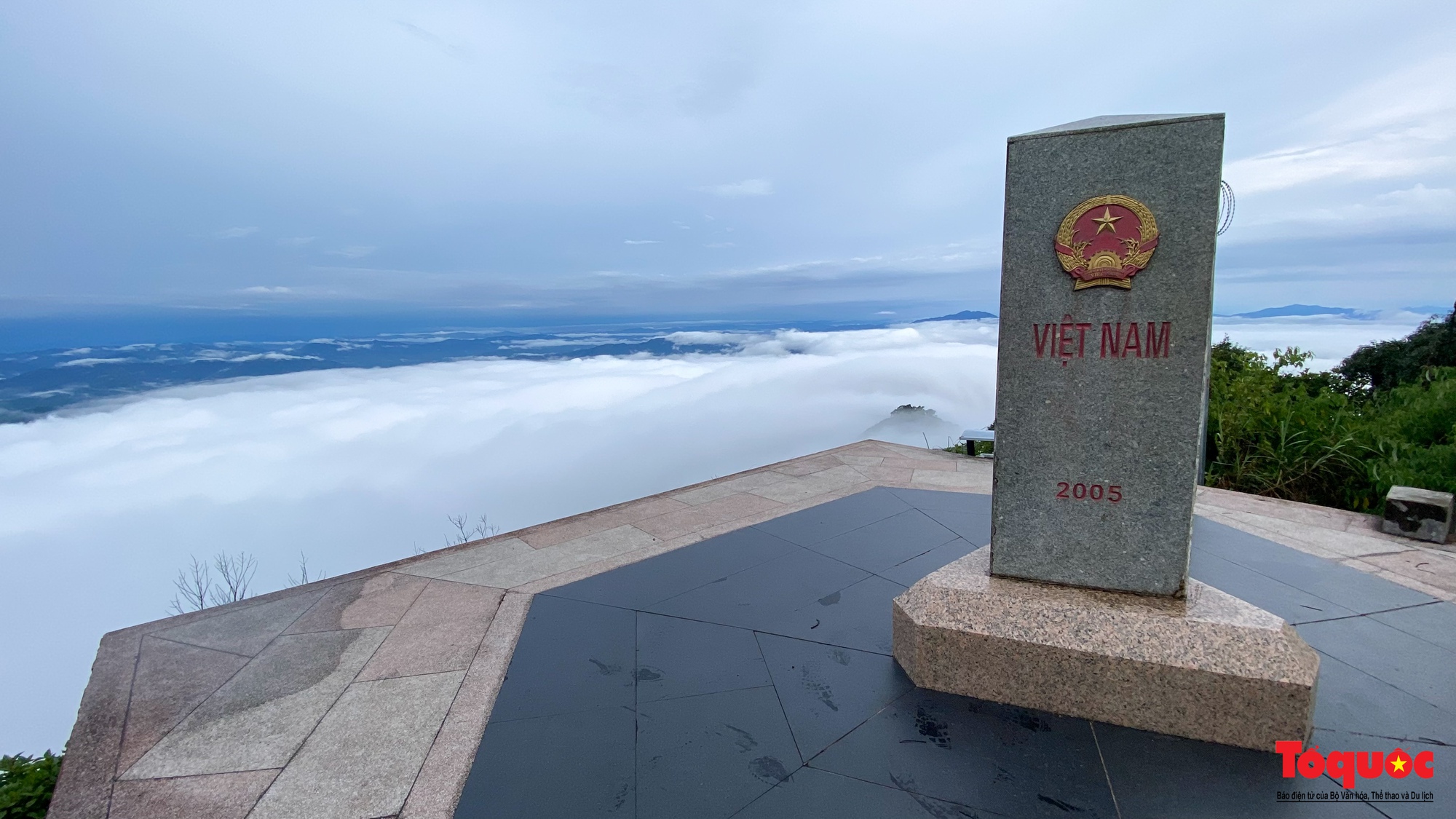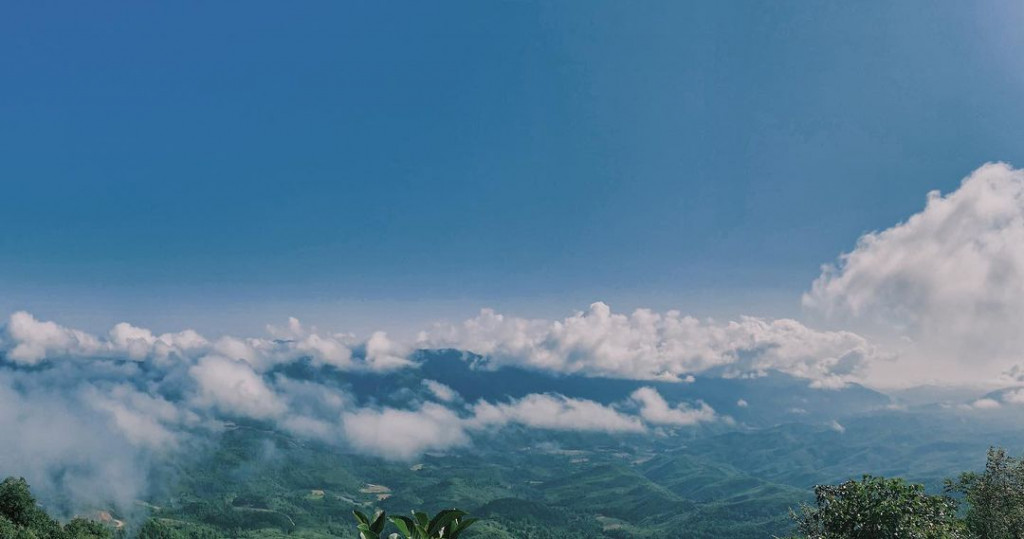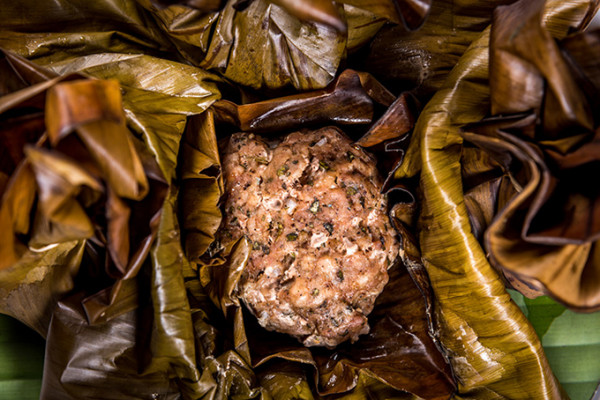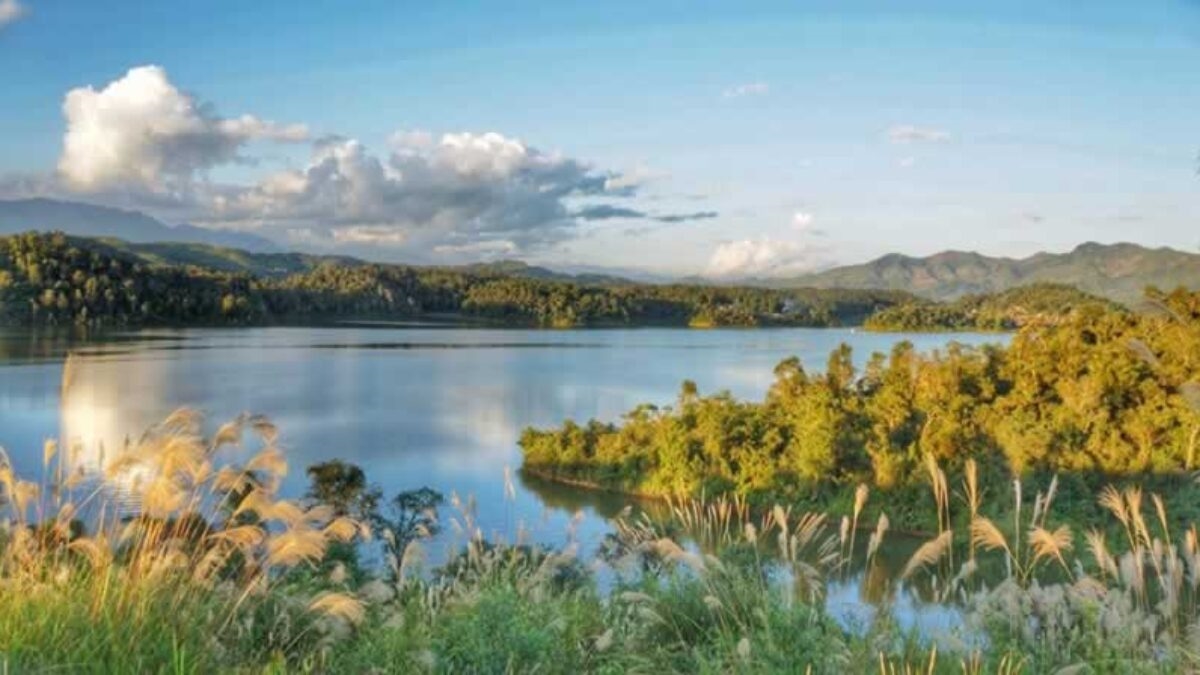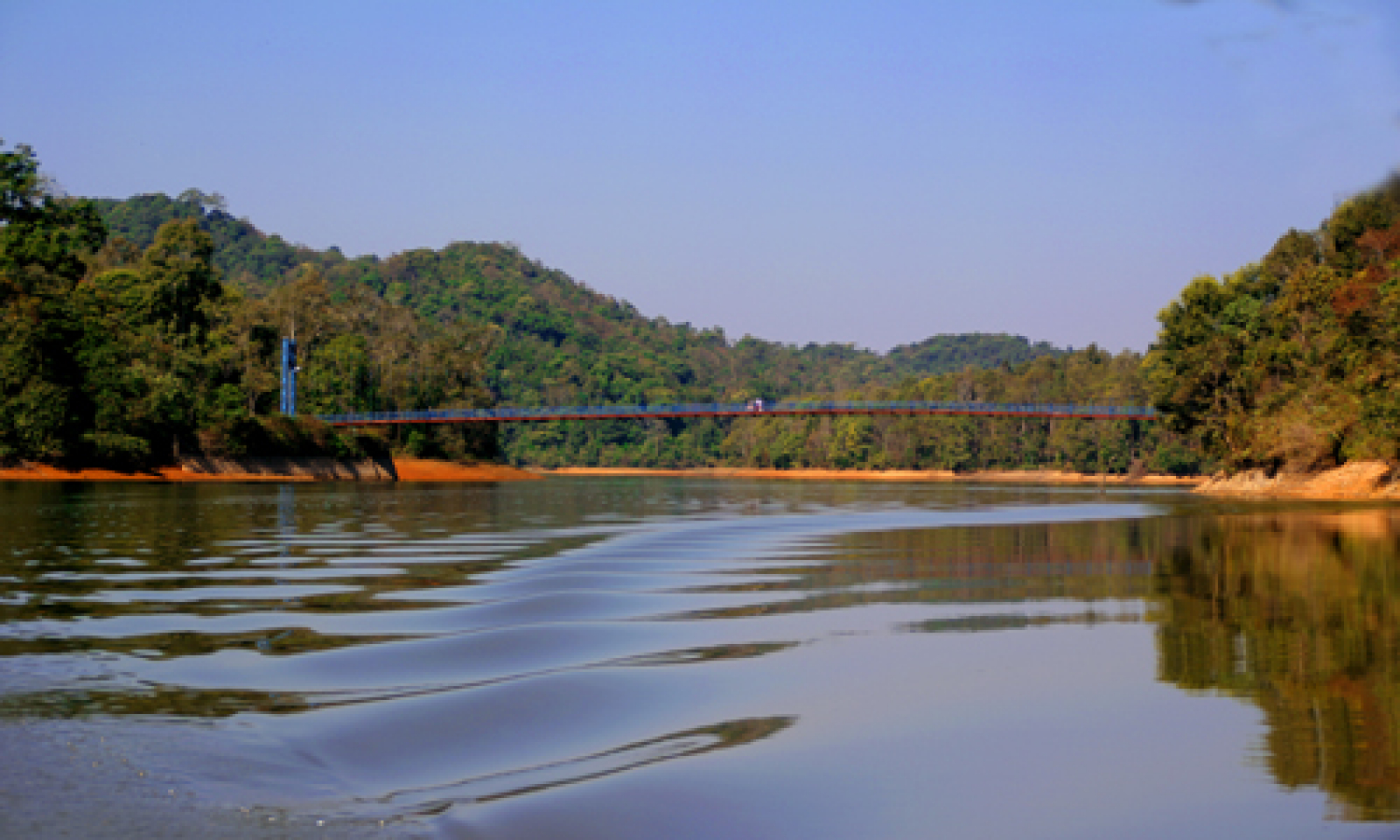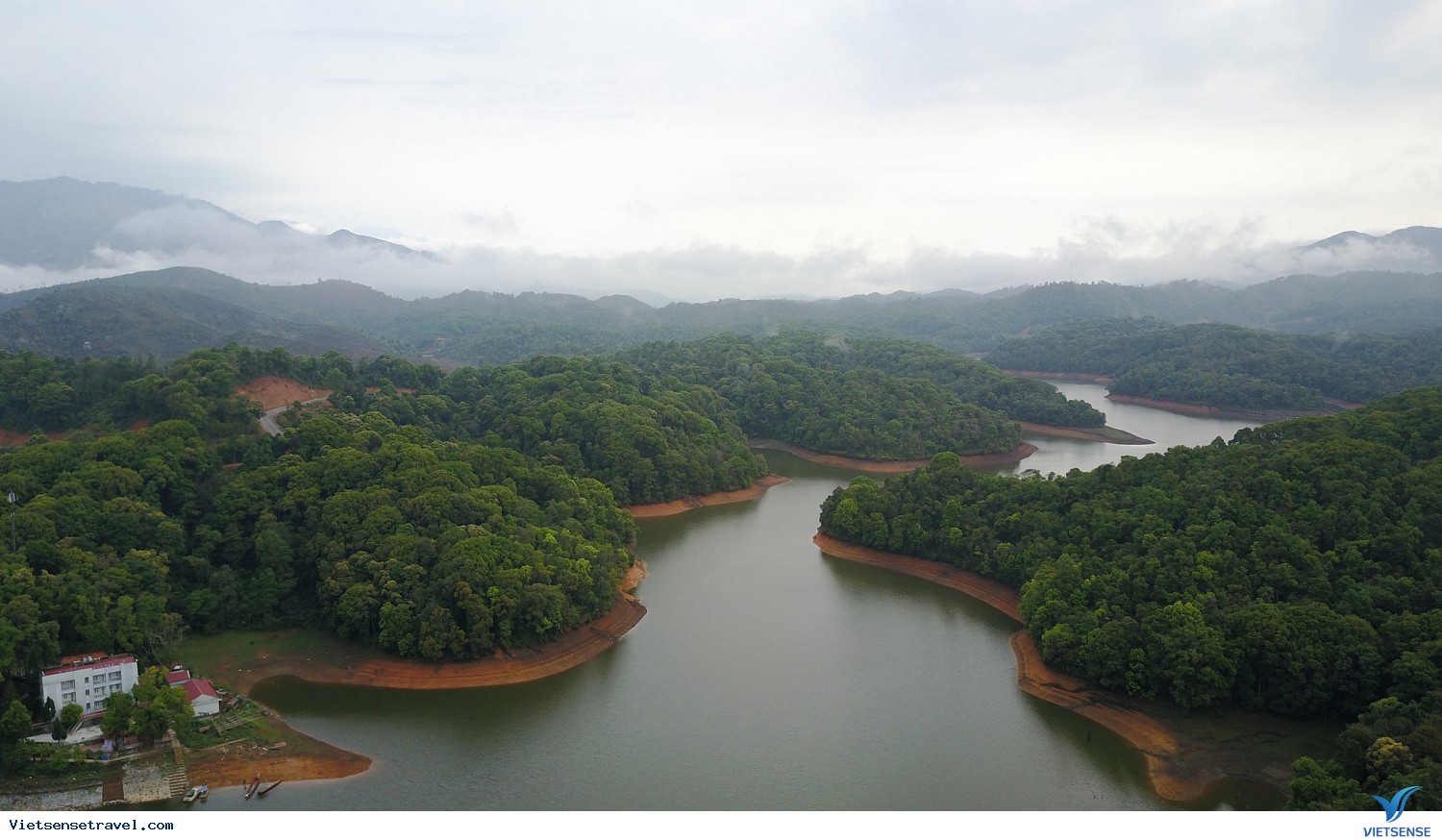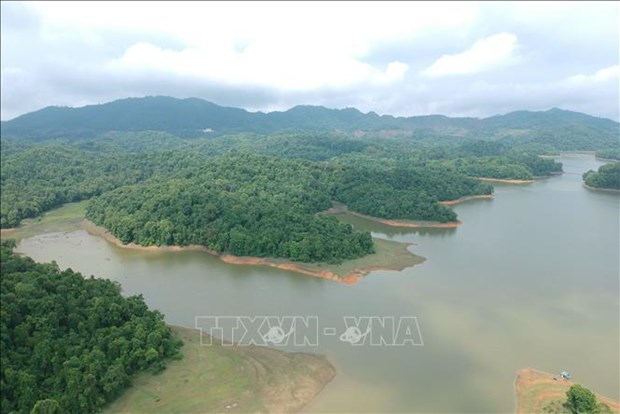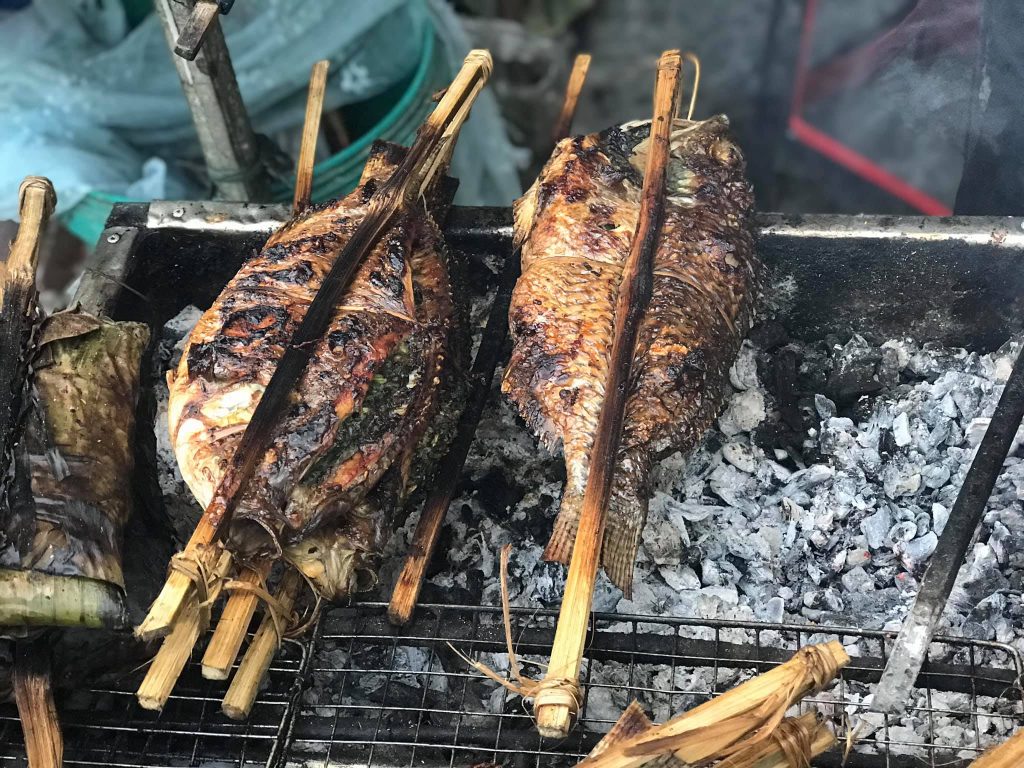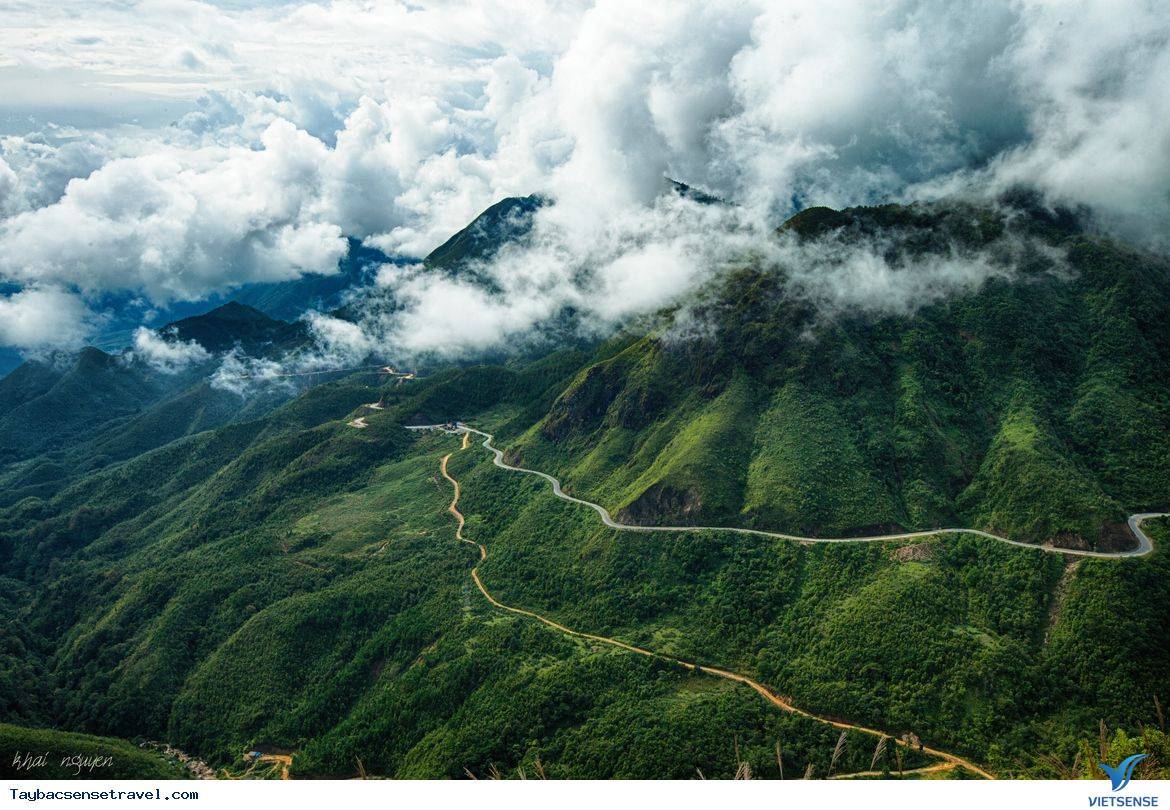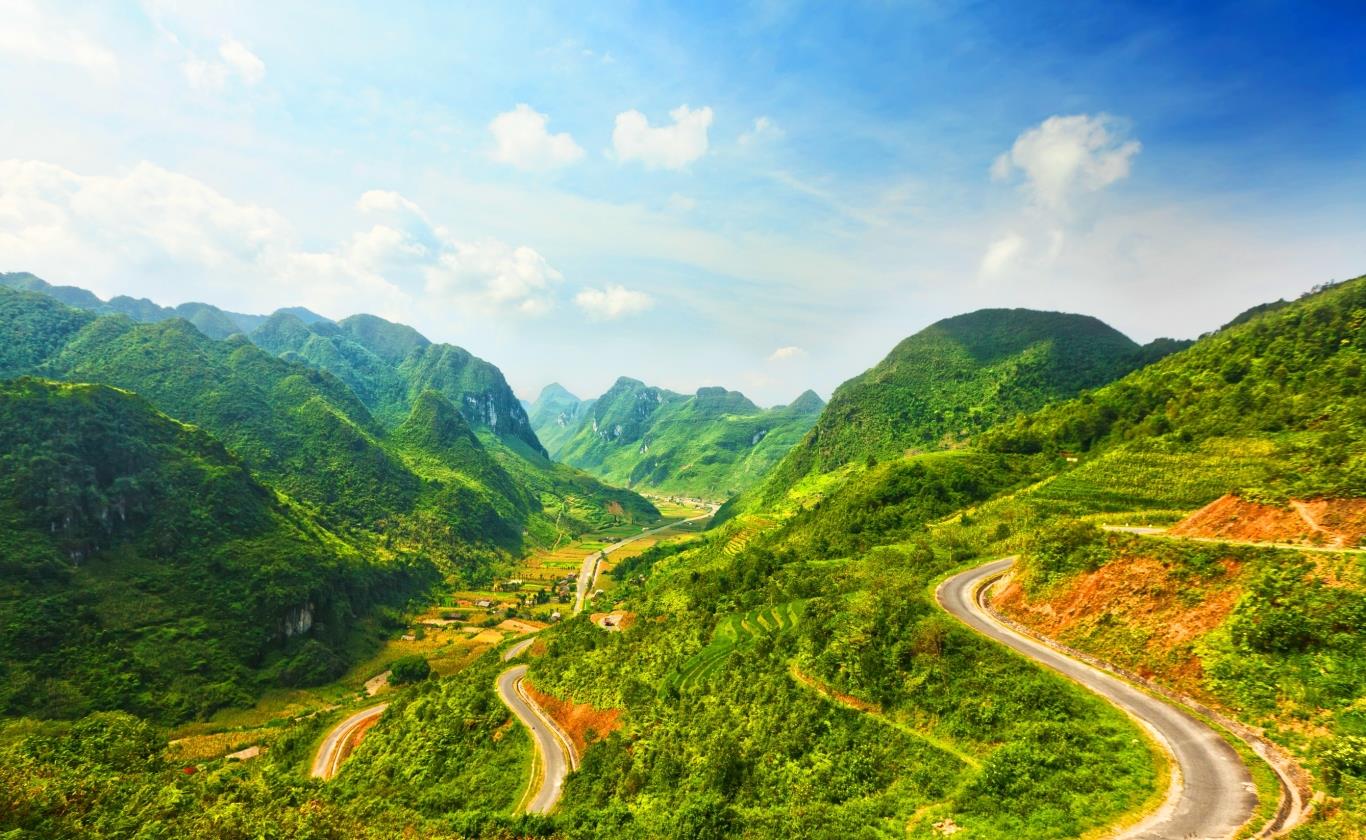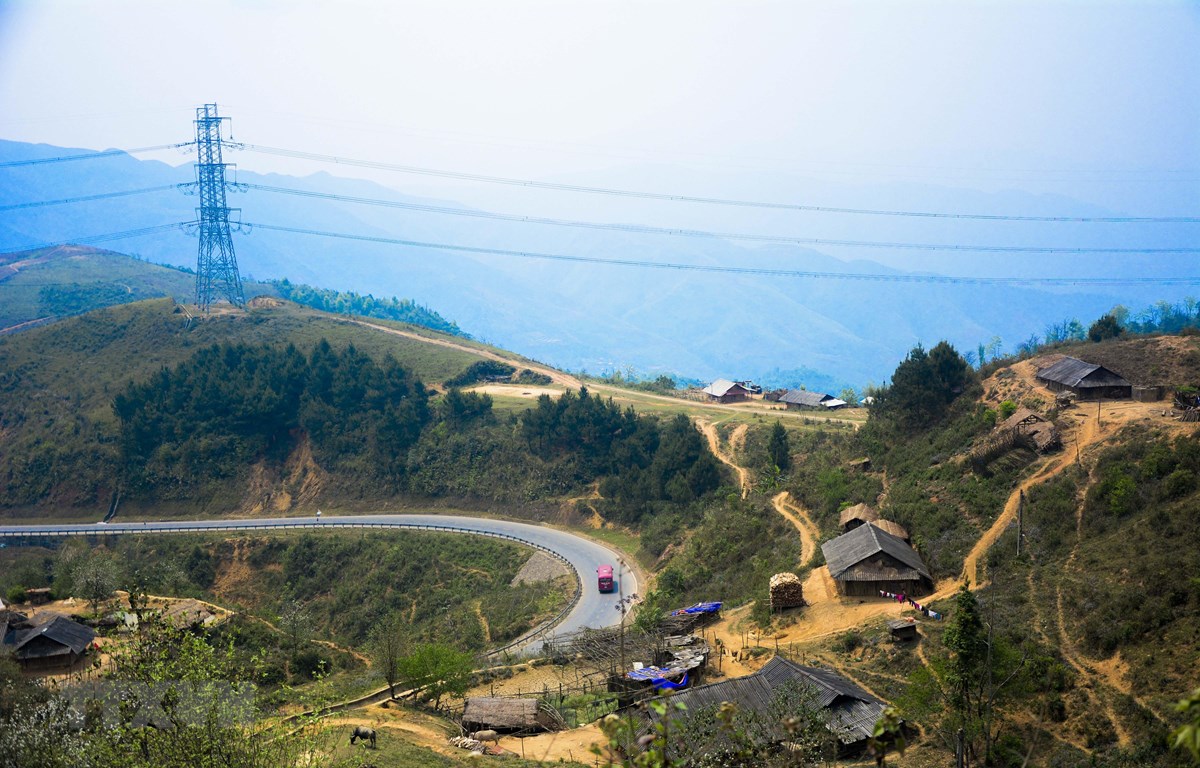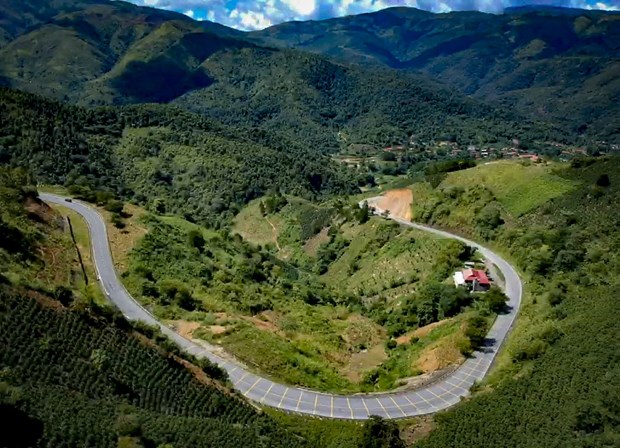Tourist destination
Na Hang tourist area
Muong Lo field is located in Nghia Lo town, located on Highway 32, about 80km west of Yen Bai city center. The vast, straight fields are the source of life for the Thai ethnic people, and are also the cradle of culinary culture and traditional traditional dances typical of this land. If Tu Le and Mu Cang Chai are extremely famous with tourists, Muong Lo is still not known to many people. However, this place possesses a very unique beauty that MIA.vn would like to suggest you visit and conquer. You can conveniently go to Mu Cang Chai by Highway 32, then you will pass through Muong Lo Field to explore. Coming to Muong Lo, visitors will be surprised by its extremely peaceful and quiet beauty. The simple small houses, the tall trees, the people who work hard every day, all create a beautiful land. Muong Lo has a terrain like a giant basin, located in Nghia Lo town and a few other communes in Van Chan district. Looking down from above, this place is surrounded by the majestic Hoang Lien Son range, the yellow color of ripe rice and the green color of trees and mountains interwoven together spreading to the horizon. The Muong Lo basin is home to more than 10 ethnic groups including Thai, Muong, Kinh, Tay, Nung, Mong... Therefore, it creates a unique cultural region with unique interwoven features. no two. For a long time, people have called Muong Lo field the land of white rice with clear water and the fragrant flavor of Tu Le sticky rice. Muong Lo rice valley is currently the second largest rice granary in the Northwest region, only after Muong Thanh in Dien Bien province, providing a huge source of food for people here. With a limited economy, mainly dependent on agriculture, Muong Lo plays a huge role in people's lives. Famous as the land of "white rice, clear water", Muong Lo has become the inspiration for many poetic works. With ecstatic beauty, each season appears before visitors' eyes with its own colors and beauty. Because the area of Muong Lo Field is very large and belongs to many localities, it creates a very special scene. At the same time, each commune will have a different farming schedule. On this side, in Nghia Lo, the rice has turned golden, while in Van Chan, the fields are still green. Therefore, creating a very unique landscape of interwoven fields. Every morning when dawn rises, the first rays of light shine down on the vast field. Images of farmers carrying hoes and sickles to the fields to weed and harvest rice, the sound of laughter and talking echoing throughout the sky. As the sky gradually deepened into the afternoon, the boys and girls drove the buffalo back to the barn, the rice flowers sparkled in the sunset, a beauty that was both peaceful and magical that made people's hearts flutter. When harvest season comes, carts laden with rice are returning home. Left behind are fields filled with straw. The smell of straw is strong, dry and yellow under the sun. Coming here this season, you also have the opportunity to participate in local people's new rice festivals, enjoy many delicious dishes and fragrant jars of wine.
Lao Cai
From January to December
3842 view
Na Hang tourist area
Lim Mong village is located in Mu Cang Chai district, Yen Bai, with a beauty that has captivated the hearts of many people. Lim Mong village is located at the end of Yen Bai, blessed by nature with breathtaking beauty and stretching rice fields, interspersed with roofs that appear hidden in the clouds, as beautiful as paradise. . It is no exaggeration to say that Ban Lim Mong is one of the extremely challenging attractions and discoveries for those who are passionate about backpacking. With an extremely dangerous road full of hardships and challenges, Ban Lim Mong responds to everyone's patience with a breathtakingly beautiful natural scenery, not inferior to Tu Le Town in Yen Bai. Between September and October is the best time for you to explore Ban Lim Mong. This is also the time when Mu Cang Chai terraced fields are at their most beautiful season. Coming here at this time, you will admire the natural scenery of Yen Bai dressed in shiny golden colors, as beautiful as a picture painted by the hands of Mother Nature. If you missed Yen Bai's golden season, you can also visit Ban Lim Mong around May to June. At this time, Yen Bai is in the flood season, so the natural scenery is extremely beautiful and poetic. At this time, Ban Lim Mong is also much more cheerful and bustling because people begin to invite each other to go to the fields to plow for a new, bountiful crop. Coming to Yen Bai and missing out on the beautiful natural scenery of Ban Lim Mong is an extremely big mistake. Located at the end of the land of clouds, the road to Ban Lim Mong is also extremely dangerous, making many backpackers restless, wanting to pick up their backpacks to come here to explore one of the most dangerous roads in Vietnam. To get to Ban Lim Mong, from Hanoi you move in the direction of Trung Ha bridge. Coming to Thanh Son (Phu Tho), continue moving straight through Highway 32 towards Yen Bai province. After arriving at the foot of Khau Pha pass, you have to pass through the Thai village at Nam stream to reach Lim Mong village located on the other side of the stream. Right from the time you are on the road to Lim Mong village, you can admire the impressive beauty of Khau Pha pass. With an altitude of up to 1200m above sea level, the spectacularly beautiful Khau Pha Pass brings a significant challenge for those who are planning to explore Ban Lim Mong. Standing from the top of the pass, you will easily admire the natural scenery of Ban Lim Mong. The beauty of Yen Bai's mountains and forests is captured in full view. Especially when Ban Lim Mong is in the ripe rice season, the rice fields stretch out in an extremely bright yellow color, adding to the enchantingly beautiful landscape. Young people often choose the top of this pass as a place to watch Ban Lim Mong, live virtual lives and especially catch the moment of sunset or sunrise. If you intend to explore Ban Lim Mong, one of the first things you need to do is to thoroughly check your vehicle and have it serviced if possible. The road to the village is extremely difficult and dangerous with many steep passes and bends, so if you are not careful, you can easily encounter mishaps in the middle of the road. Make sure you are in good health before leaving because the road to get here is not only long but also full of hardships and challenges. If you are not confident enough to drive, you should go with someone who has a strong handlebar, has experience driving long distances and is as familiar with the roads in Yen Bai as possible. You should check the weather forecast before leaving. If the weather is bad, you should consider changing your itinerary to other destinations before going to Ban Lim Mong. Especially, you should not go down a steep mountain pass at night because the road is very dark, deserted and extremely dangerous for those who are not familiar with the roads of Ban Lim Mong. Prioritize comfortable clothes and sports shoes for ease of movement because most people come to Ban Lim Mong with the desire to explore as much as possible. The terrain here is not suitable for wearing too elaborate dresses and skirts for virtual living.
Lao Cai
From September to October
4097 view
Na Hang tourist area
Yen Bai province is known to many people thanks to the impressive beauty of its charming natural scenery, the most famous is probably Mu Cang Chai. But few people know that this is also the place where the endless echo of the majestic and beautiful Pu Nhu waterfall is heard. Pu Nhu Waterfall is located in Pu Nhu village, La Pan Tan commune, Mu Cang Chai with the waterfall creating melodious sounds like a proud story about the honest, simple people of the majestic high mountains of the West. North. The waterfall is located about 10km west of the center of Mu Cang Chai district, originating from streams in the upstream forests of Lao Cai and Son La. The extremely impressive high mountain terrain here has turned that stream into the majestic, impressive waterfall it is today. The most special thing to mention is that during the flood seasons, the water here is compensated with a layer of fertile silt to help the plants grow, bringing fresh flavors and full of vitality. Nature is very clever in delicately surrounding this beautiful waterfall, only "revealing" the majestic echo of the waterfall to those from afar. That's why Pu Nhu waterfall becomes more mysterious, making everyone curious to discover it just by hearing those sounds. Before you can see Pu Nhu waterfall, you will already be ecstatic about the poetic beauty of the path leading there. The road is quite easy, just passing through the stream and cornfield, you can enjoy the cool feeling of the cool water here. If you choose to travel along the main road, it will be difficult to admire this waterfall. Do you know why? Because nature has embraced this waterfall with tall forest trees, creating a delicate hiding place for the waterfall. With a height of about 200m, the waterfall is divided into many different levels. The most beautiful is on sunny days, the Pu Nhu waterfall flows down like a white silk cloth fluttering to the joyful melodies of the whispering wind and the singing of birds in the surrounding pristine forest. If you have the opportunity to explore Mu Cang Chai on days with such great weather, you will surely admire the pristine beauty, majestic sounds and the most memorable moment is the moment of immersing yourself in the fresh air. that heaven and earth bestowed on this place. Standing proudly between two high vertical cliffs, Pu Nhu waterfall appears like a watercolor painting. The image of the majestic high mountain is like a mighty man surrounding and protecting the beautiful young woman named Pu Nhu waterfall through many ups and downs of life. Around the waterfall, there are also large rocks covered with moss that are somewhat scary, but that is also a special highlight that makes you unable to take your eyes off the strangeness. If you are struggling to find a place to let go of all your worries and relax in the fresh nature, this is truly the ideal place for you. With what Pu Nhu waterfall possesses, you will surely have a memorable trip with wonderful and impressive scenery here. Beneath the continuously flowing water of the waterfall there is also a mysterious lake called Dragon Lake. According to the people here, this lake is extremely sacred because there is a dragon sleeping at the bottom of the lake, and it is said that the Pu Nhu waterfall is the beautiful result gushed out from that dragon. Although it is only a story that has been passed down orally to this day, it has made people not dare to immerse themselves in this water, because no one dares to wake up the dragon's sleep. However, this is just a legendary story. Nowadays, tourism services here have become much more developed, you can be completely guaranteed safety during your visit. Therefore, you can still enjoy the cool water here without having to worry too much.
Lao Cai
From January to December
3950 view
Na Hang tourist area
Located in the Northwest of the country, Thac Ba Lake of Yen Bai province, a place called "Ha Long on the mountain", is one of the three largest artificial lakes in Vietnam formed when the Thac Ba Hydroelectric Plant was built. The lake is located in two districts of Yen Binh and Luc Yen. The lake has nearly 20 thousand hectares of water surface, including more than 1,300 large and small green islands, along with a beautiful cave system hidden deep within the limestone mountains. Coming to Thac Ba Lake, visitors can enjoy watching the vast sea of water and the immense islands of trees reflecting on the blue lake surface. The people here are also very friendly and hospitable. Anyone who has once visited Thac Ba Lake will surely be surprised and will never forget the clear, poetic and majestic Thac Lake. Not only does it provide water to generate electricity from the national grid, Thac Ba Lake is also a place for fresh air conditioning and a stopping point for tours. Visiting Thac Ba Lake, when traveling by boat, visitors will enjoy the fresh air amidst the vast, shimmering water surface reflecting the seemingly endless overlapping islands, forgetting all the tiredness and worries. troubles of life. The first place visitors can visit is the Thac Ba Hydroelectric Plant area, where Thac Ba Temple is located, this is Vietnam's first hydroelectric project standing tall on the lake. Having the chance to visit the country's historical works with their own eyes and hear the story of the people who devoted their lives day and night to building the factory, each visitor will be moved and more proud of the glorious national tradition. , the sacrifice of his father's generation. At the end of the trip to visit Thac Ba Hydroelectric Plant, visitors can also visit Thac Ba Mau Temple - a spiritual tourist destination not far away. The temple is located on Hoang Thi mountain, with its back against the mountain, overlooking the Chay River in the East Northeast direction, far away is Cao Bien Mountain. For a long time, Thac Ba Mau Temple has been famous as a sacred place, recognized as a Provincial Cultural and Historical Relic in 2004. Tourists visiting Mau Temple light a stick of incense, letting go of the chaos of life. , praying for peace of mind at the door of compassionate Buddha to continue the journey that takes visitors to discover the magical beauty of stalactites, of strange natural stone statues that hide many human desires and ambitions in the world. Limestone cave complexes on the lake such as: Thuy Tien cave, Xuan Long cave, Bach Xa cave, Thac Ba, Thac Ong... Thuy Tien cave, located in the heart of the rocky mountain is about 100m long with sparkling, clear stalactites. It has a picture of nine fairies, each with a unique look associated with a thrilling and attractive love legend. Visit Xuan Long cave hidden in the rocky mountains, with natural stone statues and stalactites associated with colorful legends. Along with the cave system, visitors can go up Cao Bien Mountain, the largest and longest mountain range of Thac Ba Lake. Standing on the top of the mountain, you can see the lake engulfed in mist with its shimmering and magical beauty. , feel the majestic beauty of nature, to find the ancient mark of Ngoc market, the famous Thac Ba Ivory market, once a bustling market... Sitting on a canoe up the Chay River, not far away, visitors will Visit the land of Ngoc Luc Yen with famous landscapes such as Sao Pagoda cave, Dai Cai temple... and admire the magic of natural gemstone paintings under the talented hands of craftsmen. Charming scenery, rich in aquatic resources, the lakeside is also home to many ethnic groups such as: Kinh, Tay, Nung, Mong, Dao, Phu La, Cao Lan... People here still keep local cultural identity, in which many special festivals often take place such as the New Rice Festival of the Tay people, Tet dancing of the Dao people... Coming to Ngoi Tu Cultural Village - Vu Linh commune, Yen Binh district, where 5 ethnic groups gather (mainly White Dao people), visitors will experience a relaxing life under low stilt houses. Wander among the palm forests, learn about the traditional craft of weaving shrimp baskets, and watch red-cheeked Dao girls in brilliant national costumes. In particular, every time night falls, by the flickering campfire, visitors will hear captivating folk songs and enjoy the delicate flavors of dishes such as: bamboo-tube rice, banana flower salad. forests, chicken cooked with sour bamboo shoots or fish salad, shrimp salad... Most of the villages along Thac Lake still retain their wild features, along with the cultural identities of the Tay, Nung, Dao, and Cao ethnic groups. Lan... with many unique festivals. Currently, Ngoi Tu village has many fully invested households qualified to welcome foreign guests. Every year, the village welcomes hundreds of groups of visitors, mainly from Germany, France, Italy, Sweden, Australia and overseas Vietnamese. In addition, visitors can also attend the unique boat racing festival called "Echoes of Thac Ba Lake" or visit the famous Kha Linh grapefruit village. And on that journey of discovery, visitors can also spend a little more time to visit the adjacent land of Luc Yen, a famous gemstone area in the country, visit the historical relics of Dai Cai temple, Ma Mut cave, and Sao pagoda. , Black King Mountain... where archaeologists have discovered traces of ancient Vietnamese people. Compared to Ha Long Bay on the mountain - Thac Ba Lake promises to bring tourists wonderful, unforgettable experiences.
Lao Cai
From January to December
5135 view
Na Hang tourist area
Yen Bai Giang Stream is located at an altitude of about 1,300 - 1,400 m above sea level, covered by layers of clouds all year round, plus the air is always extremely fresh and cool, making this place a hot spot. The spot is very popular with tourists, choosing it as a place to stop. Besides, this place also has a unique feature that MIA.vn believes that when you hear it, you will want to pack your things and go to Suoi Giang immediately, that is, you can feel all four seasons of the year in just one breath. in... a day in Suoi Giang. When mentioning Yen Bai, it is impossible not to mention Suoi Giang, and when mentioning Suoi Giang, it is impossible not to mention Shan tea. Stop here for a moment to let MIA.vn tell you a fairy tale about this type of tea associated with Suoi Giang. Legend has it that, once upon a time, a fairy sowed seeds in Suoi Giang and this divine seed germinated into a lush green tree. When the tree grows, it spreads its leaves and buds as white as snow. At this time, the Mong people living here were suffering from hunger and cold. They used this leaf to eat. After eating, their bodies felt healthier. It was that miracle that they believed that God had helped them, so they decided to establish a village here to live and call this place Suoi Giang. It must be said that the ancient tea trees in Suoi Giang are also very magical, they live at an altitude of 1,400 meters above sea level, the "young" trees are over a hundred years old, the older trees are over 300 years old. Yet young buds still grow green on rough, moldy white tea stems, firmly clinging to the roots on the craggy mountainside, creating a unique ancient tea garden landscape. In addition, those fat tea buds are covered with a translucent white layer, so they are called snow tea. Tea is picked and prepared with the experience and skillful hands of the Mong people. Shan Tuyet Suoi Giang tea is very unique. Although it lives in a pristine mountain area, the green tea contains all the top flavors of world-class teas in the bowl. When traveling here, there are many activities for you to enjoy this green, clean, and beautiful living space, such as closing your eyes and thinking about a bowl of fragrant tea, or carelessly drinking a cup of tea. Sleep soundly under the canopy of a huge tea tree, or immerse yourself in the lives of the people here through tea picking and tea making activities, and finally enjoy the tea that is a finished product that you have made with your own hands. It is truly an ideal destination for us to "detox" the fatigue and worries from life in the city, isn't it! Traveling to Suoi Giang, in addition to enjoying Shan tea, there are also many specialties of the Mong people waiting for you to enjoy such as: men men, Yen Bai kitchen buffalo meat, armpit pig, wild vegetables, cassava wine, corn wine,... and extremely unique dishes, blended with the flavor of ancient sweet soup such as meat rolled in grilled tea leaves, young sweet soup leaves eaten raw with herbs. The cuisine is simple and rustic but has an unforgettable flavor. Imagine sitting comfortably at the wooden dining table, in the cold weather of a quiet night, enjoying hot grilled meat skewers, accompanied by the strong aroma of wild vegetables, the heat of a bowl of wine and wine. Occasionally "coating" your mouth with the sweet taste of men men made from corn, it will definitely make you want to take a once-in-a-lifetime trip with your best friends.
Lao Cai
From January to December
3758 view
Na Hang tourist area
La Pan Tan is a highland commune in Mu Cang Chai district, Yen Bai province. With its location on the top of Khau Pha, nearly 2000 meters above sea level, La Pan Tan commune possesses an extremely beautiful natural picture with terraced fields, towering mountains and indigenous culture. H'mong people. From Mu Cang Chai town to La Pan Tan commune, about 15km, visitors can easily reach the destination by going in the Northeast direction. After the journey through the mountain passes, you will come to a beautiful land with up to 2,200 hectares of terraced fields arranged in layers. In the past, La Pan Tan commune used to be a poor commune, the "capital" of opium when up to 80% of the population was addicted. However, that "dark" period has gradually passed when the commune received adequate investment to develop tourism. The lives of local residents have gotten better. In 2007, La Pan Tan was recognized by the Ministry of Culture, Sports and Tourism as a National Scenic Monument. With a prime location in the high mountains, cool climate and average temperature of about 19 degrees Celsius, this place has become a favorite destination in Mu Cang Chai for many tourists. The journey to explore La Pan Tan commune brings you countless memorable experiences in both the beautiful scenery, culture and people here. If you discover La Pan Tan commune for the first time, you will probably be immediately overwhelmed by the beautiful scenery here. On the journey to visit this Northwest highland commune, visitors will enjoy the beautiful scenery of terraced fields surrounded on all sides. As one of the communes with the most terraced fields in Mu Cang Chai, everywhere you look you will see rice fields overlapping. It is truly admirable for the farmers here, with their human strength and rudimentary agricultural tools, they can turn the mountains and hills into beautiful fields, curving beneath the mountain slopes. Terraced fields lie gently along the hillsides, extending to the stream banks, weaving into the villages. Everywhere are rice fields. Exploring La Pan Tan commune, visitors can check in many beautiful places here. Among them, Mam Xoi hill is the hottest coordinates of each ripe rice season. This hill is supported by terraced fields below, and above has a round shape like a tray rising to the sky. Every golden rice season, Mam Xoi Hill attracts many tourists to check in and take photos. According to the experience of many tourists going to Mu Cang Chai, Mam Xoi Hill is most beautiful in the early morning at dawn when the golden sunlight has just gently crept onto the fields, surrounded by white mist covering it, painting a picture. beautiful like a fairyland. Near Mam Xoi hill, there is a small wooden shack owned by local people, where visitors can sit and admire the scenery and enjoy taking photos. Visiting La Pan Tan during the ripe rice season in September - October, visitors can both admire the beautiful terraced fields and have the opportunity to watch people harvest rice manually. The image of Hmong women with small sickles quickly harvesting each clump of rice in the field is so beautiful and simple. Coming to La Pan Tan, Mu Cang Chai district, in addition to terraced fields, visitors can also explore the beautiful waterfall here. That is Pu Nhu waterfall with a height of more than 20 meters, pouring loudly into Dragon Lake and creating a very majestic and mysterious scene. Around Pu Nhu waterfall are large and small rocks covered with moss, leading to a peaceful, poetic forest of ancient trees. Coming to Pu Nhu waterfall, you can spend time admiring the beautiful scenery, taking photos or camping around the lake shore. Indigenous people believe that Dragon Lake is a sacred place so no one goes to bathe. However, later when local tourism activities are promoted, visitors can experience bathing in the waterfall to feel the cool water here.
Lao Cai
September to October
4077 view
Na Hang tourist area
In recent years, every year, around the end of September and beginning of October every year, tourists from all over the country flock to Mu Cang Chai to admire the wonderful scenery of the highland land. This. Coming here, visitors can not only enjoy the beauty of terraced fields and the sea of white clouds on top of Cao Pha pass but also immerse themselves in the unique cultural festivals of the Mong people. Mu Cang Chai is a western highland district of Yen Bai province, 180km from Yen Bai city center, more than 300km northwest of Hanoi capital. This land is located at the foot of the Hoang Lien Son mountain range, at an altitude of over 2,000m above sea level. Coming to Mu Cang Chai, visitors can take Highway 32 in two directions. If from Hanoi, you will go to Yen Bai, from Yen Bai to Muong Lo 70km, sleep here so that you can drive from Muong Lo early tomorrow morning and arrive at Mu Cang Chai in the afternoon. This section is nearly 100km long, but more than 80km is a steep mountain pass that continuously advances. Once it reaches an altitude of 1,750m, covered with mist and clouds, it will soon reach Mu Cang Chai town. In the middle of the pass, there is a flat land, stop here to enjoy the fragrant Tu Le sticky rice that is famous throughout the region. In the second direction, tourists go all the way to Noi Bai - Lao Cai highway, go to Sa Pa and pass O Quy Ho pass, then go through Tan Uyen and Than Uyen of Lai Chau to reach Mu Cang Chai. Coming to Mu Cang Chai even once, visitors will feel the richness of nature, the uniqueness of culture, and the warmth of human love. The road to Mu Cang Chai is far and difficult, but very interesting. The scenery changes constantly on the road. Tourists have not yet had time to see all the Thai stilt houses on the vast Muong Lo field with countless white daylilies before they have reached the winding, meandering roads on the steep hillsides. stand. Geological movements have created high peaks for Mu Cang Chai such as: Pung Luong (2,985m), Phu Ba (2,512m), Mo De (2,100m)... Through Khau Pha Pass (2,100m high), this is The highest mountain peak in the "four great passes" of the Northwest is covered in a sea of floating clouds, with a cool climate all year round. The top of Cao Pha Pass is also the 4th most beautiful place in the world for paragliding pilots, for those who love thrills and adventure games to conquer the sky and enjoy admiring. Explore the majestic natural beauty of heaven and earth from the air through paragliding. From here, from pass to pass, mountain to mountain, visitors will clearly feel the change in altitude. On both sides of the road are beautiful terraced fields that make each of us feel stunned. overwhelmed. The beautiful small town of Mu Cang Chai is nestled between two mountain slopes with peaceful villages in the green valley or on Khau Pha pass. Accounting for 90% of the district's population, the Mong people in Mu Cang Chai have 4 groups: Mong Do (White Mong); Butt Swing (Black Butt); Mong Linh (Mong Hoa); Mong Si (Red Mong), they reside on mountain slopes from 800 to 1,700m high with rich traditional and unique cultural features that always attract many researchers. Coming here, visitors can visit Mong ethnic villages, explore the culture and customs of the Northwest highlands with many unique folk cultural and artistic values and famous products. language. Watch the Khen dance, go with Mong boys and girls to the Sai San festival, experience some traditional crafts such as blacksmithing, flax weaving, jewelry making and enjoy traditional dishes of the Mong people. . In particular, tourists cannot miss and visit Thai village, just cross the bridge right in the center of the district (towards Che Tao commune where there is a conservation area for ornamental species) and then turn left about 1km to get there. Thai version. A small peaceful village located in the middle of the valley, its back leaning against the mountain. Here, visitors will enjoy Thai specialties, take a herbal bath in the traditional Thai way, rest in a stilt house and organize exchanges, light a campfire, and dance. Coming to Mu Cang Chai, visitors can enjoy the beauty of the Mu Cang Chai National Scenic Rice Terraces complex with a total area of 330 hectares distributed mainly in 3 communes Che Cu Nha, La Pan Tan and De Su Phinh, The place has been recognized as a National Landscape by the Ministry of Culture, Sports and Tourism since 2007. The terraced fields here are as beautiful as the fingerprints of heaven, an artistic architectural work full of creativity from the couple. the skillful hands of the Mong people. Not just now but for a long time, the harsh land of Mu Cang Chai with the meaning of "dry tree village" in the Mong language has become a symbol of human diligence and persistent creativity. From an arid, deserted land, the Mong people who are good at climbing passes and crossing mountains have cleverly turned each bed of land and each hill into beautiful terraced fields, not only providing a source of food to feed the community but It also adds highlights to nature, turning wild mountains and hills into unique masterpieces imbued with the traditional cultural values and creative feats of the Mong people. The fields are level by level, each level hugs the mountain slopes. Throughout the 13 communes and towns of Mu Cang Chai, there are terraced fields. The terraced fields are most beautiful in May-June when the fields are in the flood season and September-October when the sticky rice is ripe and shiny golden spreading across the hillsides. Tourists come to Mu Cang Chai at these two times to witness firsthand the green and yellow raspberries appearing among the vast hills and mountains. Stopping at the three communes of La Pan Tan, Che Cu Nha and De Su Phinh, everywhere visitors can see terraced fields spread across the hills. Visitors will not be able to help but admire, admire, and appreciate the glorious brocade painting between heaven and earth woven by the "peasant artists" of the Northwest. This entire mountainous area is a beautiful picture of the Northwest highlands painted by blue sky, white clouds, high fields and a simple, simple but realistic life down to every look and smile. laugh.
Lao Cai
May to June
4390 view
Na Hang tourist area
A Pa Chai is located in Sin Thau commune, Muong Nhe district, 250 km from Dien Bien Phu city, is the westernmost point of the country, where there is a landmark dividing the boundary between the three countries Vietnam - Laos - China. This is called the border junction located on the top of Khoang La San mountain, 1,864m above sea level, welcoming many tourists every year, especially young people from all over the country to visit. , conquer. Previously, A Pa Chai was considered a difficult landmark to conquer because the road to the landmark was difficult, having to cross three head-high thatched grass hills, cross forests, wade streams, and climb high mountains, which took four to five hours from The border guard station has just arrived. It's different now. In 2018, Dien Bien province completed the concrete road along the cliffs and built steps, making it easier for visitors to conquer the milestone even though they still have to walk a few kilometers of small, steep and climbing concrete roads. 500 steps to reach the landmark. The border junction marker placed on the top of the mountain is triangular in shape, with three sides facing three directions, each side has the country's name engraved in its own national language and the national emblems of the three countries of Vietnam, Laos and China. From the high point of the westernmost point of the country, looking into the distance is a vast space, majestic mountains and forests. The three-sided landmark dividing the boundary of the three countries Vietnam - Laos - China shimmers in the sunlight. Emotion and national pride surged.
Dien Bien
From January to December
5249 view
Na Hang tourist area
Pa Khoang Lake is located in Pa Khoang commune, City. Dien Bien Phu; About 8km from Highway 279 and from the city center. Dien Bien Phu is nearly 20km to the Northeast. In the language of the Thai people, Pa Khoang means "bamboo forest". Mr. Quang Van Viet, Chairman of the People's Committee of Pa Khoang commune, said: In the past, countless bamboo trees grew around the lake. Thai people here have a funny saying that "look up and see the sky, look down and see bamboo". Local people often use bamboo to make fishing rods and some household items. In addition to ensuring irrigation for 5,000 hectares of Muong Thanh fields with 2 rice crops, Pa Khoang lake also regulates the climate, limits the harmful effects of floods, and stores water for two hydroelectric projects: Thac Bay and Na Loi. . With the advantage of diverse vegetation, the forests around the lake are rich in all kinds of animals; Many species of plants and animals floating and under the lake bed. In 2004, on the occasion of the 50th anniversary of the Dien Bien Phu victory, the road leading to Pa Khoang Lake was paved. Also at this time, 4 motels, both luxurious and rustic, with nearly 100 rooms were opened; Cultural villages of the Thai and Kho Mu ethnic groups were also deployed with a total area of over 1,000 hectares. To get to Pa Khoang Lake, visitors can move from Highway 279 along Highway 279b into Muong Phang commune. Or you can follow the road southeast of the city. Dien Bien Phu passes through Ta Leng commune. These two routes lead visitors through winding roads along the lake, occasionally appearing behind the forest canopy on the clear blue surface of Pa Khoang Lake... Visiting Pa Khoang Lake, visitors can row a boat on the rolling waves, creep into every corner of the islands, and discover the magic of the natural world. Visitors can also walk through the forest to enjoy the scenery and visit villages of the Thai ethnic group. The people here are very friendly and hospitable; Visitors will be invited to attend cultural exchanges, enjoy art and culinary dishes, such as sticky rice, bamboo-tube rice, grilled fish, smoked meat... In winter, mist covers the lake surface, creating a magical watercolor painting. Summer comes, the lake surface is clear and gentle, reflecting the mountains, clouds, sky and dark green forests. In 2015, the Prime Minister approved the "Master plan for development of Dien Bien Phu - Pa Khoang National Tourist Area, Dien Bien province until 2020, vision to 2030". The general goal of the planning is to develop the Dien Bien Phu - Pa Khoang Tourist Area by 2020 to basically meet the criteria of the National Tourist Area; By 2030, it will truly become a National Tourism Area with a system of synchronous and modern technical facilities; is a highlight and milestone on the tourist route through the Northwest region, creating a driving force to promote tourism and socio-economic development in Dien Bien province.
Dien Bien
From January to December
4730 view
Na Hang tourist area
Pha Din in Thai is called "Pha Din", in which "Pha" is heaven, Din is "earth". The name of this pass means the place where earth and sky intersect - the name is enough to help people imagine the remoteness and danger here. Pha Din Pass is about 100km from Dien Bien Phu city. This is considered the boundary between Dien Bien and Son La provinces. Pha Din is located at an altitude of 1000m above sea level, with a total length of about 32km. The starting point of the pass is 66km from Son La City, and the end point is about 84km from Dien Bien Phu City. Pha Din, along with O Quy Ho, Khau Pha, and Ma Pi Leng, make up the four legendary passes of the Northwest highlands. Tourists from far away who want to conquer this great pass need to come to Hanoi by bus, train or it is best to book a plane ticket to Hanoi. From Noi Bai airport, visitors can book an airport shuttle on Traveloka to get to the city center. From Hanoi, to Son La - the starting point of Pha Din Pass by sleeper bus, limousine or motorbike. This pass is located on Highway 6, connecting the two provinces of Son La and Dien Bien. Backpackers starting from Hanoi will travel along Highway 6 through Moc Chau - Yen Chau - Mai Son - Thuan Chau plateau to reach the starting point of Pha Din pass. If you depart from Dien Bien Phu City, you will follow Highway 279 towards Tuan Giao district. Each season, Pha Din Pass has a different beauty. But the most beautiful seasons in Pha Din are spring and summer. Spring is the season when wild flowers bloom. There are pink peach blossoms, pure white plum blossoms, and banyan flowers filling the sky. March is the season when ban flowers bloom - a typical flower of Dien Bien province and is also considered the most beautiful season by backpackers. Summer in the delta provinces is scorching hot, but the climate in Pha Din is cool and pleasant. Winter with drizzle, cold weather and more dangerous roads is not the ideal season to conquer Pha Din. In addition, from May to August is the rainy season in Dien Bien. Before starting your journey, you should closely monitor weather developments. Because the Pha Din area is a red soil mountain, not a limestone mountain. When there is a lot of rain, extremely dangerous landslides can occur. Most tourists and backpackers come here to satisfy their adventurous spirit. The rugged mountain pass and majestic nature here seem to have a strange hypnotic power. Looking back from afar, the long pass road curves like a rope suspended between mountains and hills. The terrain here is extremely dangerous with a cliff on one side and a deep abyss on the other. The highest point of Pha Din pass is 1,648m above sea level. The slope of the pass ranges from 10% to 19%. The mountain pass is zigzag with 125 dangerous curves, A-shaped and Z-shaped curves with a curve radius of less than 15m. Going from the starting point to the top of the pass, each natural picture slowly opens, both majestic, breathtaking and poetic. At the foot of the pass are scattered villages. Halfway up the pass, clouds covered it. Looking down from the slope of the pass is the vast Muong Quai valley. Approaching the top of the pass, there is only the deep sky and majestic, vast mountains and forests. When conquering Pha Din, don't forget to stop to admire the scenery at Ang Nua valley or check in at Pha Din Pass - a 50ha tourist area built by Pha Din cooperative. Vitality is present throughout Pha Din pass. On the conquering route, visitors will encounter images of highland markets when passing through Phong Lai commune, Thuan Chau district, Son La province or Toa Tinh commune, Tuan Giao district, Dien Bien province. People gather at the market to buy and sell agricultural products, medicinal herbs, and mountain and forest products. Tourists can also stop to buy some to take home as gifts. What makes Pha Din Pass more special than the other three great Northwest passes is that this pass is associated with the famous Dien Bien Phu campaign in five continents, shaking the earth. During the resistance war against the French, Pha Din was the route to supply and transport artillery to Dien Bien Phu and became a symbol of the brave spirit of 8,000 young volunteers. To block this supply route, the French army sent planes to bomb Route 6 continuously for 48 days and nights. Among them, Pha Din Pass was one of the two places that suffered the most from bombs and bullets. Now, Pha Din Pass has been recognized as a National Monument, a testament to the nation's history.
Dien Bien
From January to December
4870 view

